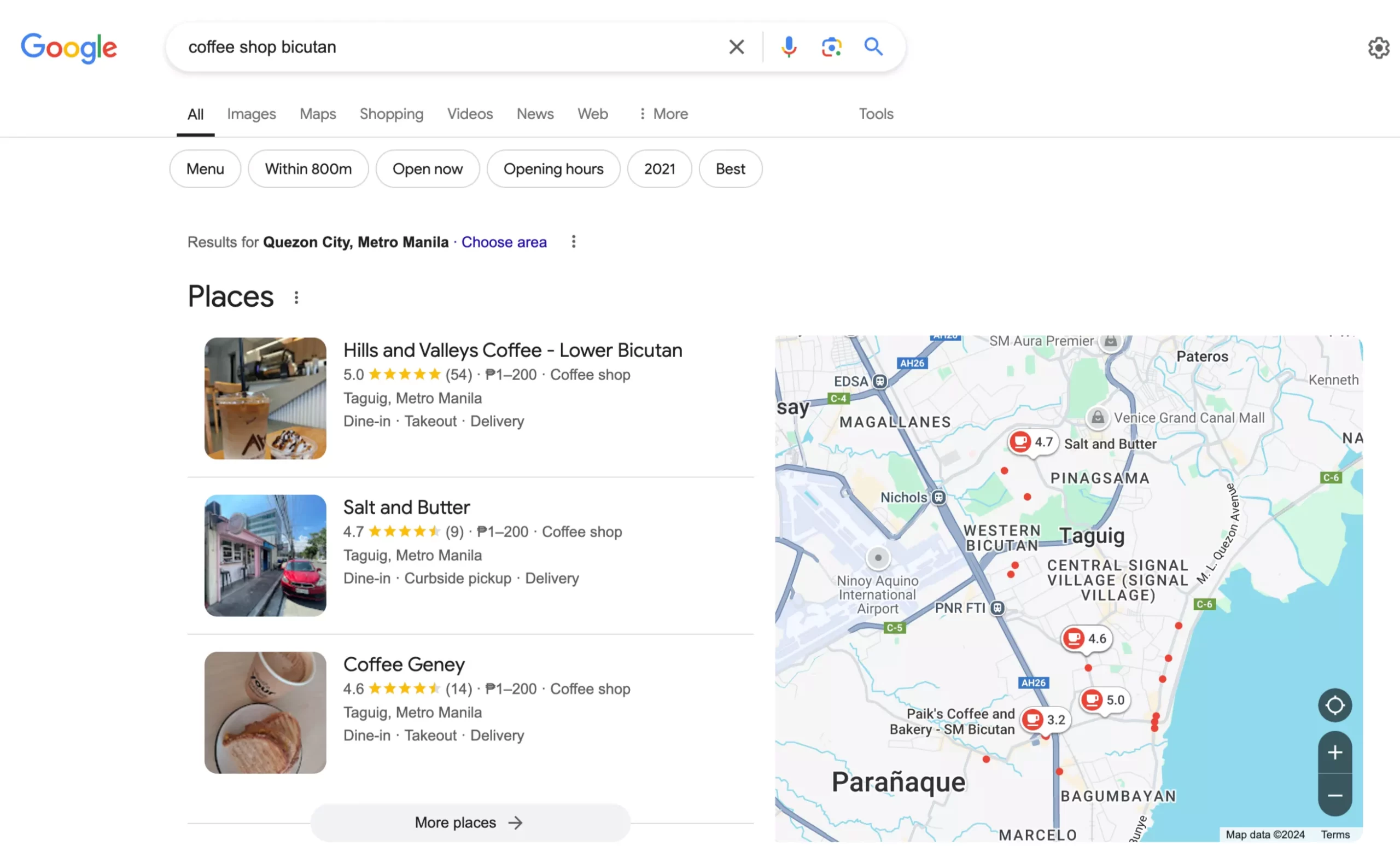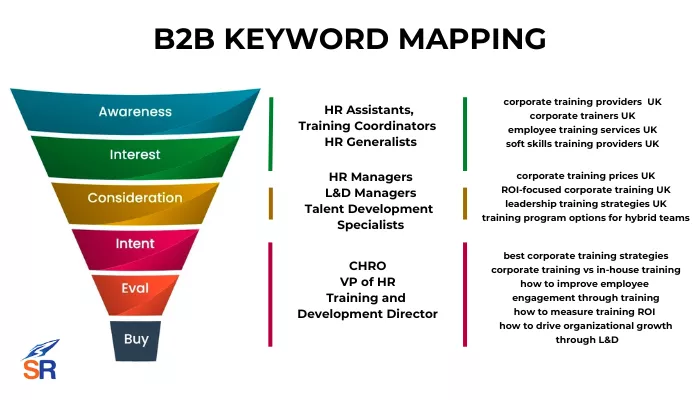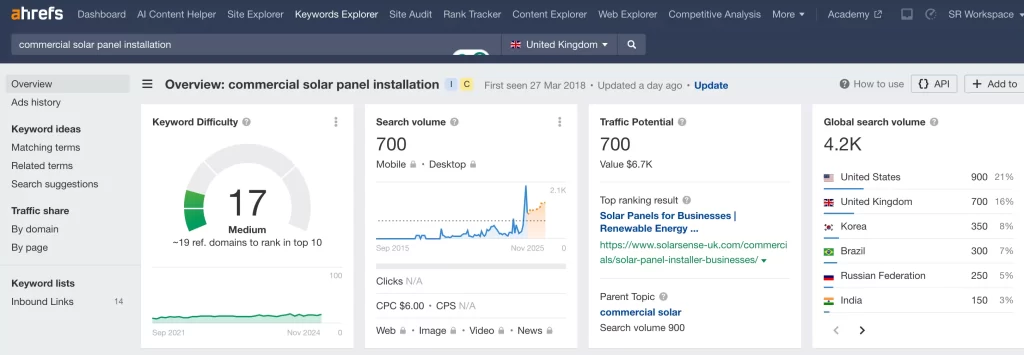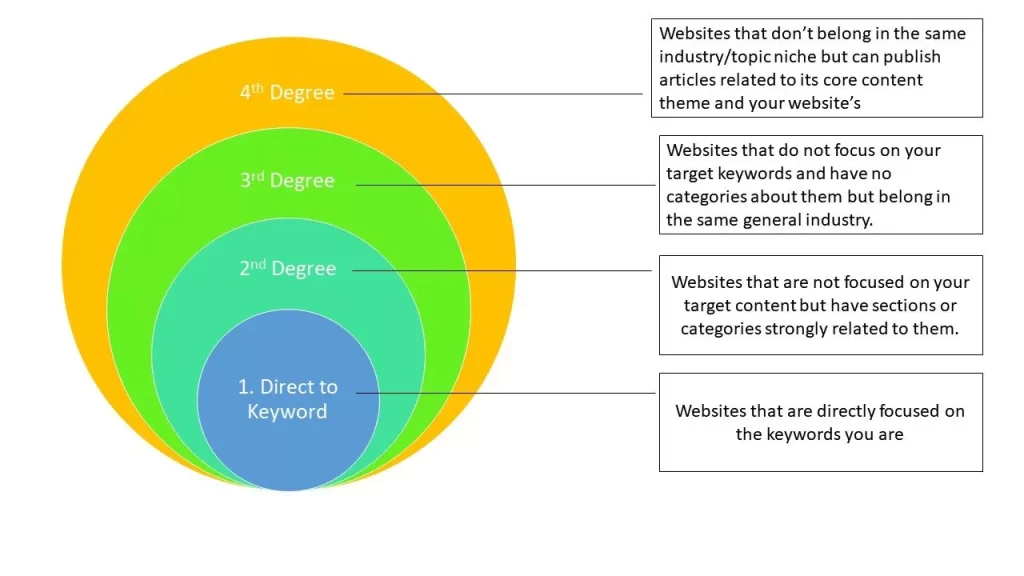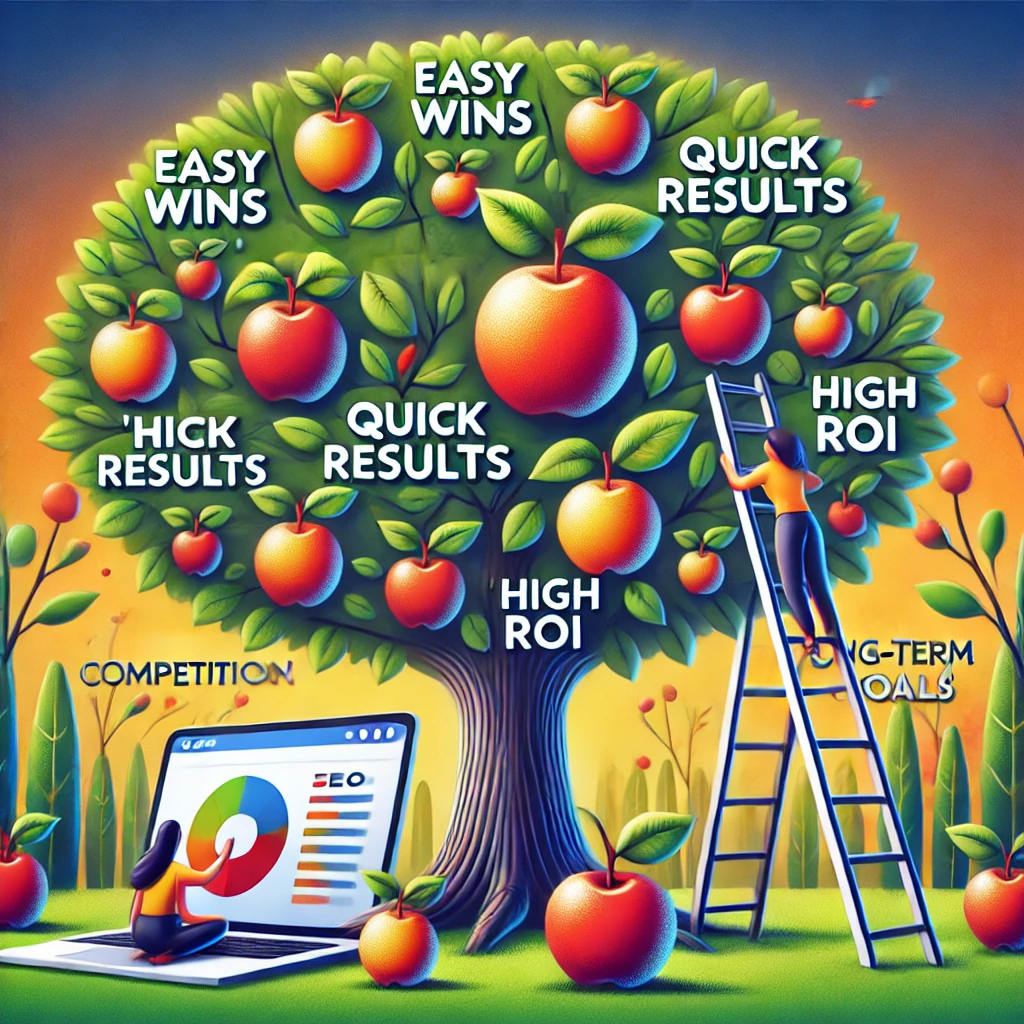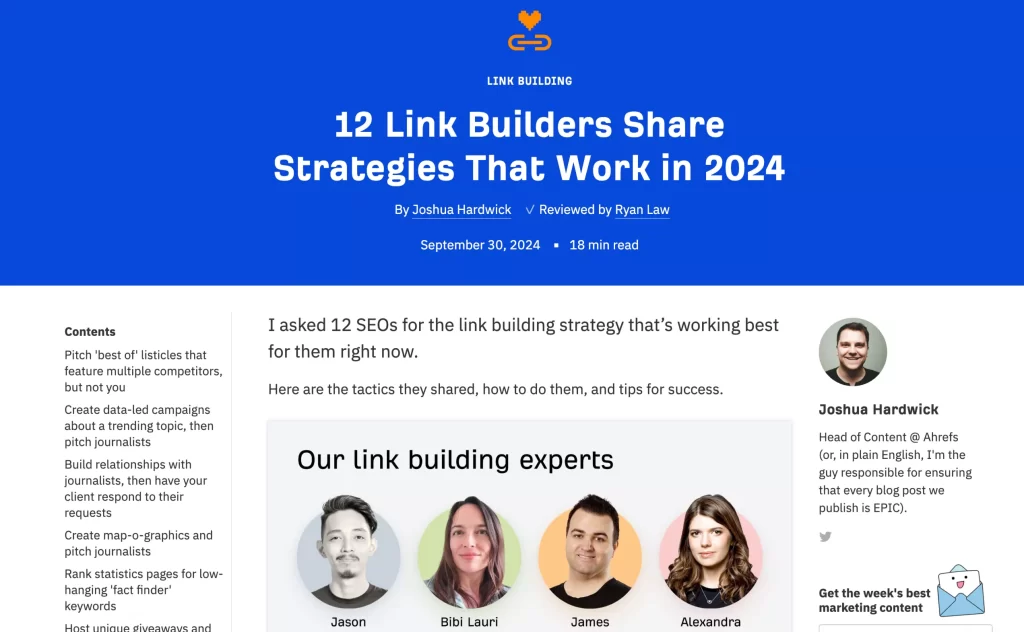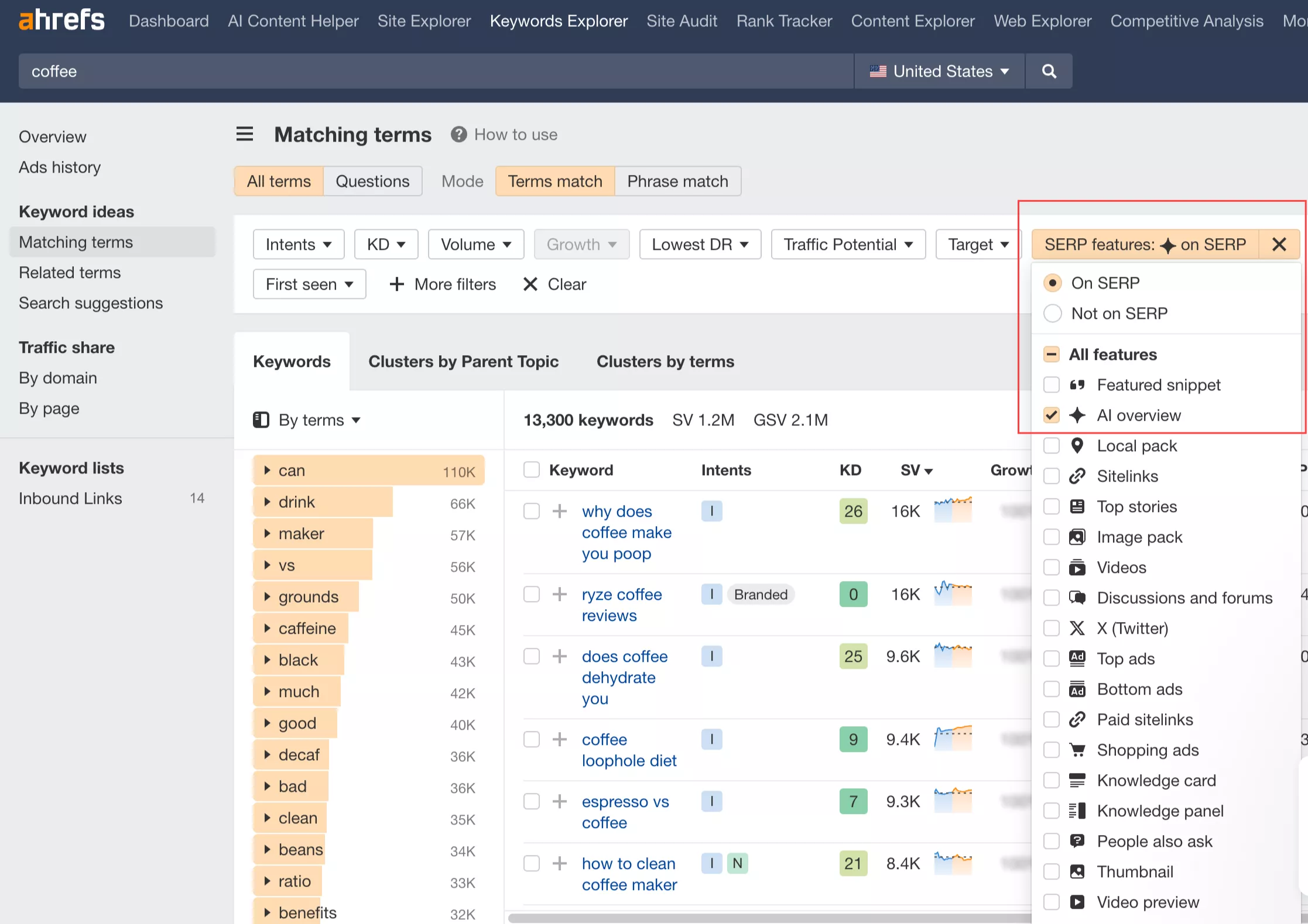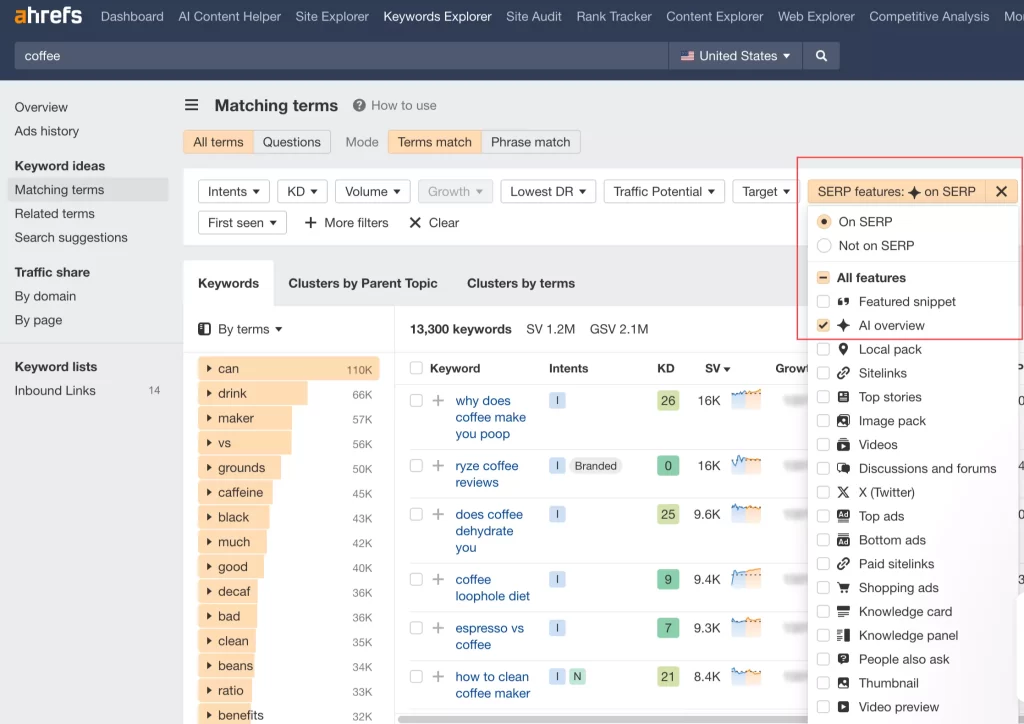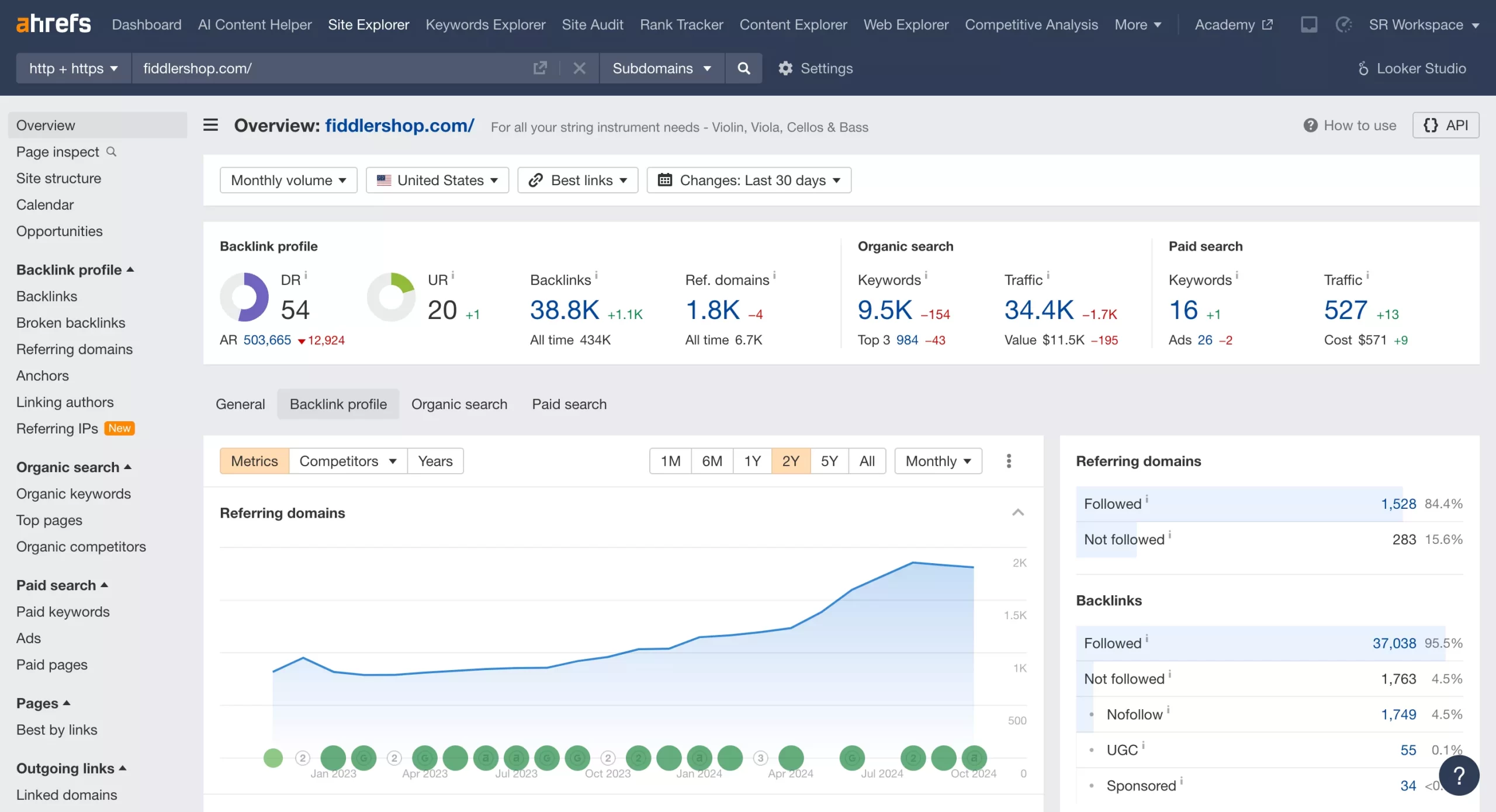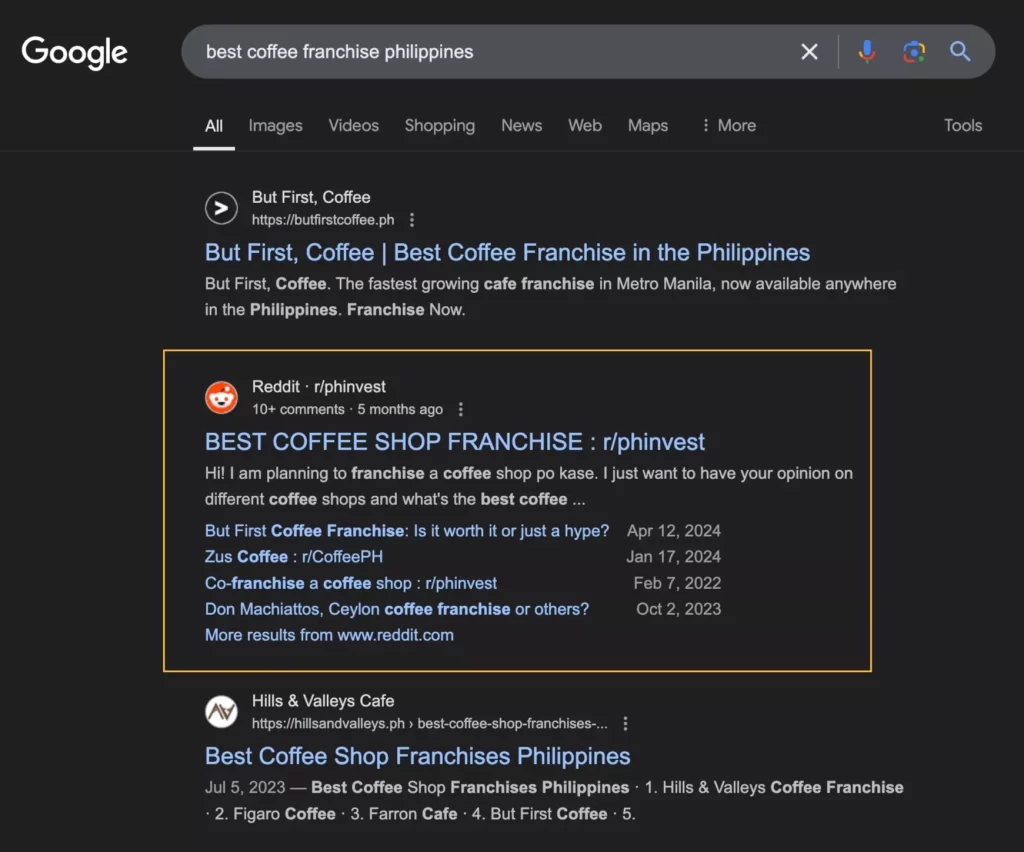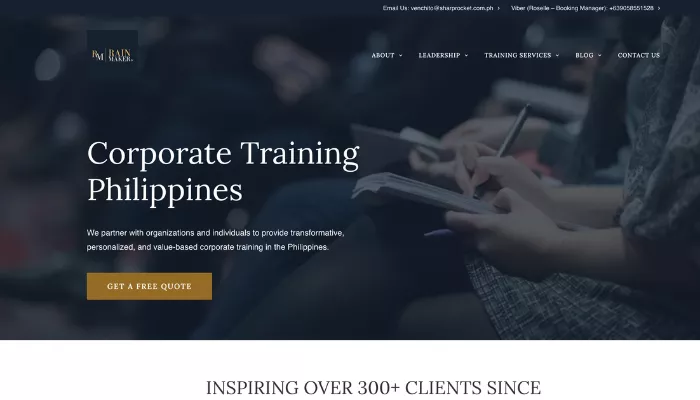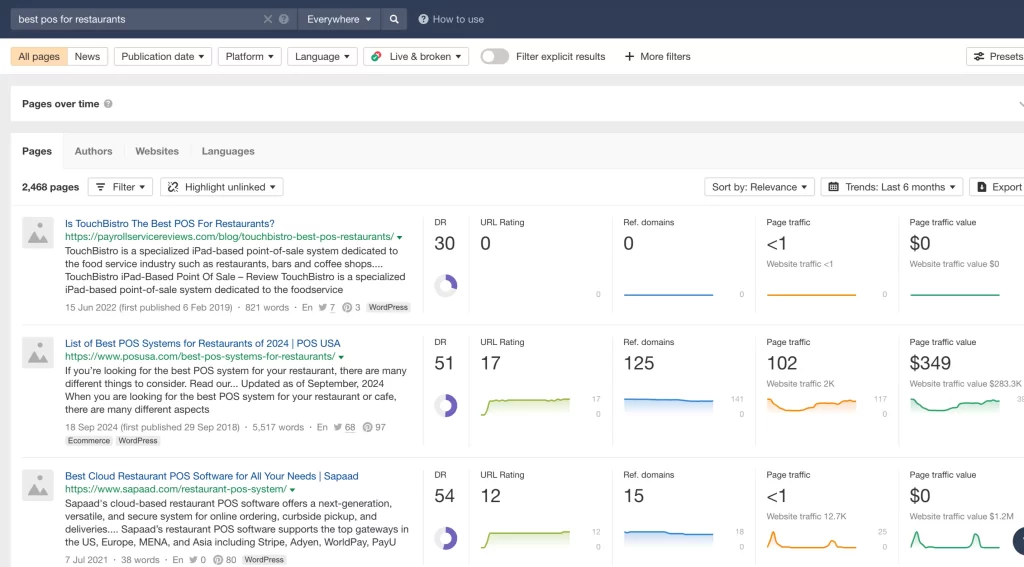SEO for the Google Maps Pack: Rank Better Locally
The Google Maps Pack occupies prime real estate on search results pages. It gets more clicks than your site will receive from ranking top spots for local organic search listings, making it an imperative area of local search optimization that marketers must take advantage of.
Even if you rank #1 for organic search listings, it’s still an excellent addition to your arsenal to dominate Google Maps Pack.
I’ve used it to rank one of my local businesses—a coffee shop in Bulacan and our franchise in Taguig—and have been driving nearby customers, making it one of the important channels to drive more physical visits to our stores.
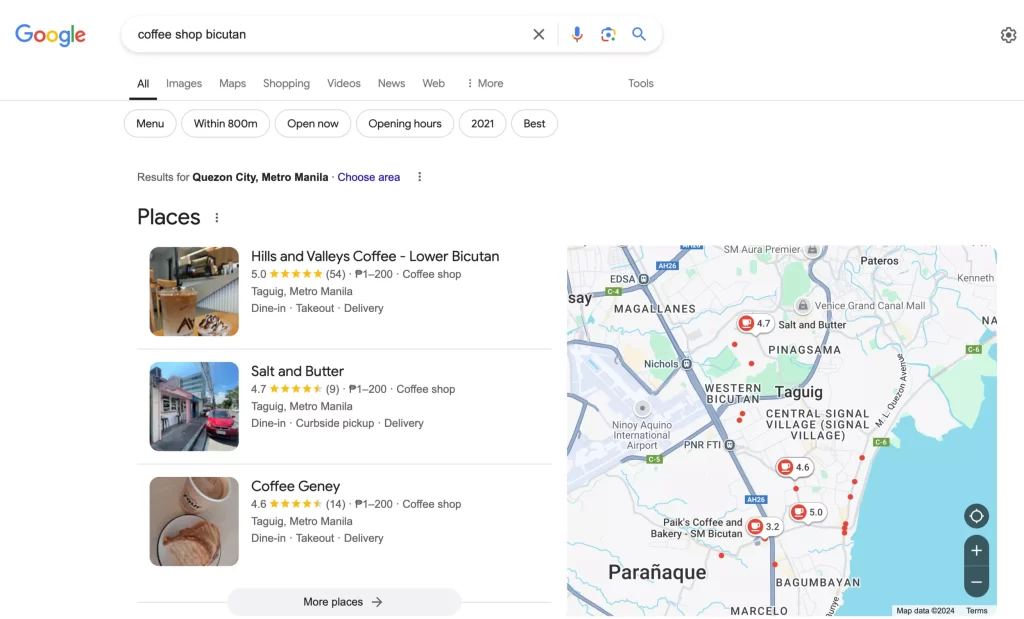
Here are some tips for leveraging SEO for the Google Maps Pack.
1. Claim Your Google Business Profile (GBP)
If your brand is famous in the industry and many customers visit your location, you may have a Google Business Profile visible on a search. You just need to claim it as its rightful owner.
Otherwise, if the store hasn’t opened yet, like in our case, weeks before our store opening, we already created our Google Business Profile for our upcoming branch.
Simply go to the Google Business Profile and follow the verification process. They usually will send you a code by mail or phone. Once verified, you can edit your Google Business Profile and optimize it for local searches.
Once you have claimed your Google Business Profile, fill out all the necessary details, including your Business Name, Address, and Phone Number. Spend as much time as necessary adding other important details in every information field.
The goal here is to provide as much context about your business as possible for Google to recognize it and to provide business information for your potential visitors.
2. Ask for Customer Reviews
Getting legitimate customer reviews helps Google recognize the authenticity of your brand and gives potential customers a glimpse of your business’s customer experience.
Whether the reviews are positive or negative, what matters most are actual reviews from your customers.
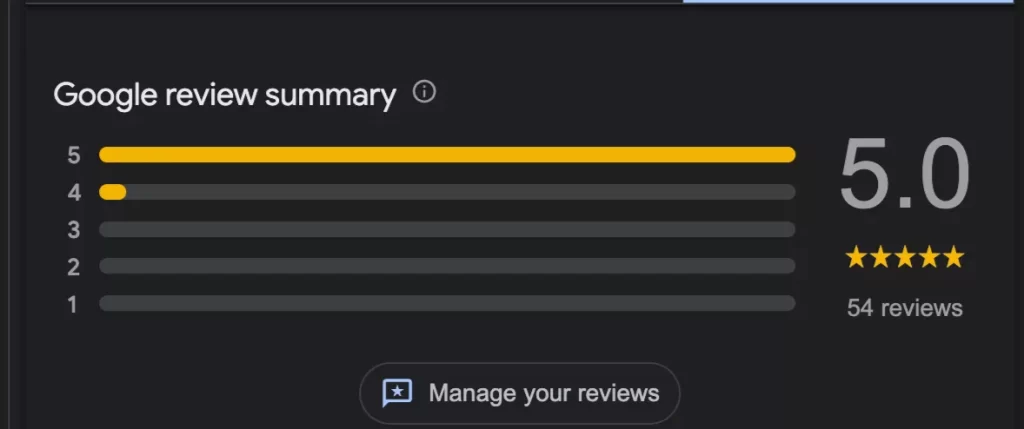
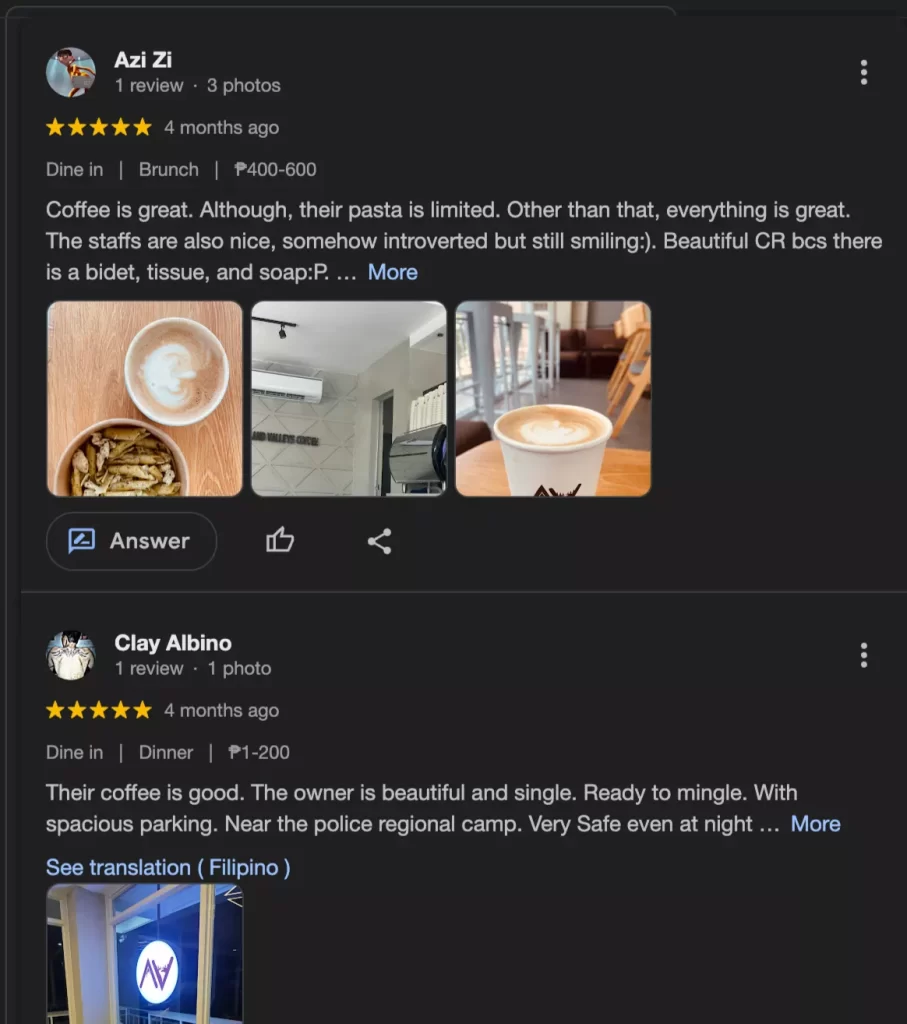
Here’s how to encourage customers to review your GBP:
Politely ask customers for reviews after a sale or service. Train your front liners (customer service or sales team) to request a GBP review from every satisfied customer. It doesn’t hurt to ask.
Send follow-up emails or texts with a direct link to your GBP review page. This could be through Viber or any other digital channel.
Another effective way to get reviews is incentivizing customers to review your product or service. For instance, during my honeymoon with my wife, we had a relaxing spa in Bangkok, Thailand. After the spa service, we were asked to scan a QR code, incentivizing us for the review - getting 50% off for the next visit.
You can also apply the same strategy to acquire new reviews for your GBP. Display signs in your physical location, encouraging people to give feedback.
Pro Tip: Respond to every review, whether positive or negative. This shows engagement and increases trust signals with future customers, showing you value every customer experience.
3. Choose the Primary Category That Aligns With What Customers Search
Google allows you to select a primary category and up to 9 secondary categories. Choosing the right primary category will enable you to appear first on Google Map Packs for specific search queries.
For instance, if you own a Bakery, choose “Bakery” over “Restaurant.” Match your primary category to your business’s core offerings.
Next, the second categories allow you to target additional search queries. For example, in the given bakery example, you could add “Catering” or “Dessert shop” as secondary categories to broaden your reach, enabling you to dominate Google Map Packs for any of those search queries.
4. Achieve NAP Consistency
NAP consistency refers to having the same Name, Address, and Phone Number across all online platforms and websites. Getting this right helps build your business's legitimacy in the eyes of Google.
By using tools like BrightLocal, you can automate monitoring of NAP across local citations and directories, helping you edit those profiles to match your business's exact NAP.
5. Get Local Citations
Part of doing link building for local sites is getting as many local citations as possible for your website. Create business profiles on Yellow Pages, LinkedIn, Yelp, and local business directories, as well as social media profiles such as Meta Page and LinkedIn Page.
Make sure NAP is also consistent across these local profiles.
You can use Whitespark to find more citation opportunities and manage the consistency of NAP details across these platforms.
6. Publish Localized Content
Increase the frequency and quality of localized content you publish on your site. Targeting localized keywords (e.g., "coffee shop in Bulacan") can help you dominate in more localized rankings.
Part of localized publishing is the ability to use local language and references that resonate well with your audience. So, for instance, if you want to write an article about “Top Coffee Shops in Manila,” you must include the specific places and addresses of these coffee stores while giving people exact directions.
If you ever visit the place, you may also recommend your favorite beverages. Adding personal insights and experiences could increase user engagement and enhance the helpfulness of your content.
7. Set Driving Locations to Your Business Address
Set driving directions to your business on Google Maps to make it easy for customers to find you. This is an underrated technique for climbing rankings on Google Map Packs.
As your potential customers use the directions on Google Maps, it generates positive signals for your GBP listing and improves more of its visibility.
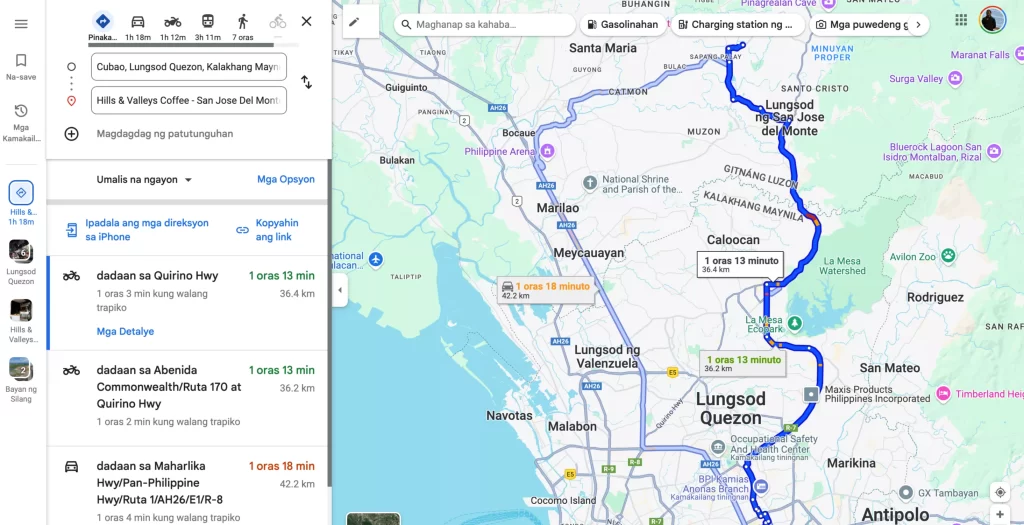
How to promote driving directions:
- Share your location links on social media. Include it when you’re writing captions to entice your followers to use Google Maps when finding directions to your store.
- Include your Google Maps and Waze links in email campaigns.
- Add “Find Us on Google Maps” to your website. Make it visible on the homepage, footer, or header.
8. Get More Engagements With Photos
Legitimate businesses have actual photos of their physical store, of their customers, and of their customer experience.
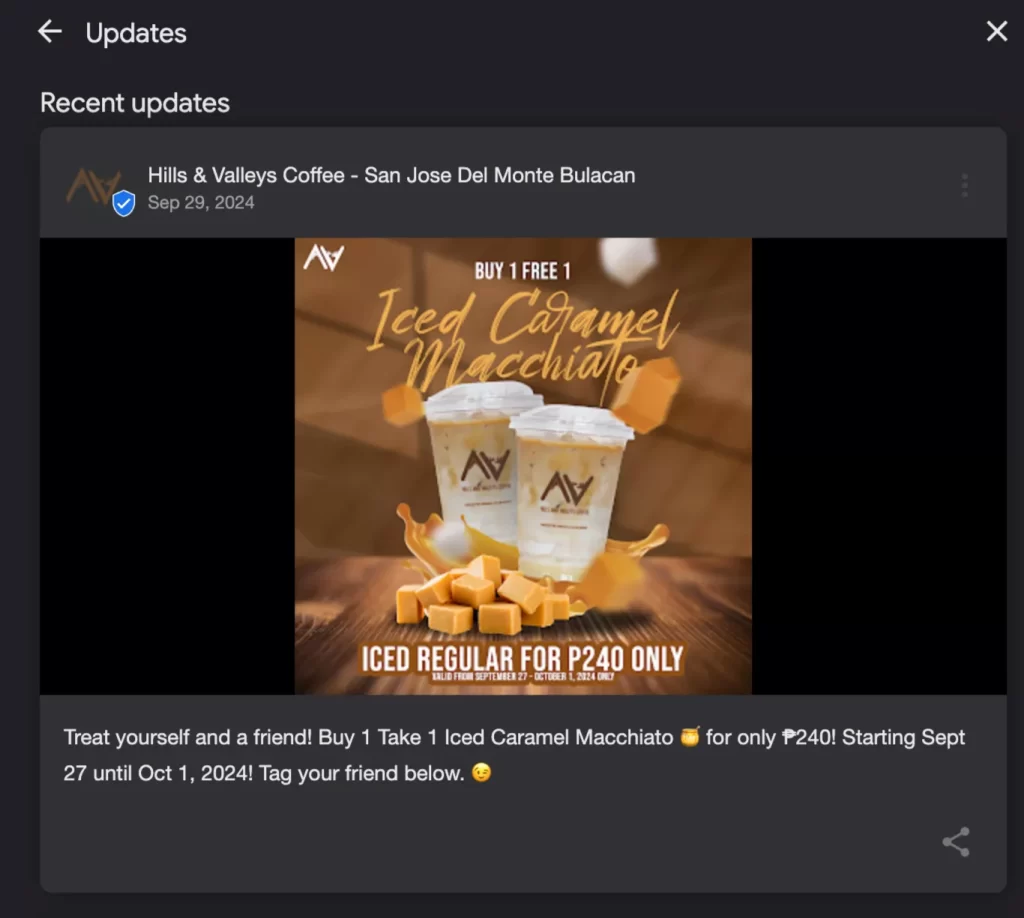
Upload images of your store, products, and team regularly to your Google Business Profile. You can also use geotagged photos to improve location relevance.
Tip: Ask your front-line staff to encourage customers to upload photos and reviews to your profile after visiting your business.
9. Infuse Attributes: Highlight Your Business’s Key Details
Attributes include features like wheelchair accessibility, vegetarian options, kid-friendly environments, and outdoor seating. These help your customers make the purchase decision, as they have nuances and preferences before visiting a store. For example, some customers would want to know if they can bring their pets to the store (so keyphrases like “pet friendly coffee shop” would be more likely their search keywords).
Navigate to the “Info” section in your GBP and select applicable attributes. Highlighting attributes not only improves your profile’s completeness but also appeals to niche audiences with a variety of preferences.
10. Upload New Offers to Your GBP
Regularly updating your Google Business Profile with offers and promotions keeps it dynamic and engaging.
For instance, we upload limited-time discounts, seasonal sales, and new product launches to our Google Business Profile at Hills & Valleys Cafe.
It is suitable for local rankings and keeps our existing customers updated with our latest store campaigns, which would keep them visiting more often.
Be Intentional in Ranking Your Google Maps Pack
Maintaining a Google Business Profile may be an underrated strategy for some, but if taken seriously, it could drive more search visibility and foot traffic to your stores.
As more people use Google to search for nearby stores for their daily needs, you’ll likely attract new customers organically if you rank for Google Maps Pack, without spending a single dime on advertising.
B2B SEO: Simplified Guide to Better Rankings
B2B companies are increasing their budgets and investing heavily in SEO and content strategy like never before.
In fact, if you run an SEO agency, B2B SEO is one of the most lucrative types of campaigns you can deal with, as the few leads they acquire from search correspond to their monthly SEO investment.
Consider one client closed for a commercial solar panel worth thousands of dollars—a few clients of this sort justify their investment in SEO.
While most SEOs are familiar with running B2C SEO campaigns targeted at regular consumers (e.g., eCommerce SEO), B2B SEO has many nuances in its decision-making process and customer journey, which are both critical to developing the right SEO strategy and link building.
Why B2B SEO Requires a Unique Approach?
Lower Search Volumes, Higher Traffic Value
Unlike B2C markets, B2B keywords often attract lower search volumes.
However, these keywords represent users further along the buying journey and are ready to make high-value decisions.
For instance, consider the traffic value for this specific keyword, “commercial solar panel installation,” at $6.7K (not to mention the traffic value of its other keyword variants).
Longer Sales Cycles
B2B buyers typically go through extended research and evaluation phases. So, your SEO strategy must support users throughout the funnel—from initial awareness to final purchase decisions.
You can’t simply rely on typical keyword research. You have to map out the entire buyer cycle for stakeholders and the keywords they may be searching for, depending on their current roles.
Multiple Stakeholders
B2B decisions involve a variety of roles and perspectives.
Creating content that addresses the needs of different stakeholders—decision messengers, influencers, and decision-makers—ensures relevance and increases the chances of conversion.
Unlike B2C, where you target individual consumers, B2B SEO involves a variety of roles. Therefore, expanding your reach with your content strategy would be crucial in significantly increasing search traffic and conversions.
Now, let’s take a look at key fundamentals in B2B SEO.
1. Understand the Business, Stakeholders, and Decision Makers
You can’t start any B2B SEO campaign without knowing the intricacies of the client’s business you’re serving with. Effective B2B SEO begins with understanding the client’s business and the key players in the buying process.
As mentioned earlier, unlike B2C decisions that may involve a single buyer, B2B purchases require collaboration between multiple roles, including decision messengers, influencers, and final decision-makers.
Let me give you tips on how to develop a deeper understanding of your client’s business:
Conduct Consultations and Meetings
Start by meeting with internal subject matter experts (SMEs) and product managers of the client’s company. Discussions with them will provide insights into the business’s goals, products, and unique selling points. They can also help you gather information about the typical customer base and their challenges.
You can develop worksheets to organize data and information as you accumulate them during your consultation. This approach is not one-time meetings but consistent consultations to better understand their client base, product offerings, and how search could help them acquire new leads.
Beyond keyword research, you should go exactly to the points of your client’s target market. This will later translate into a better content strategy and format for the blog, which you will strategically publish.
Listen to Sales Calls and Review Proposals
Sales calls and proposals are rich sources of industry-specific jargon and standard terms potential buyers use. Familiarizing yourself with this language ensures your content resonates with its target audience and meets their expectations.
I recommend this highly when you’re doing SEO for B2B SaaS, where the majority of the sales activities are done in calls and software presentations. Recording these sales calls, assessing them, and seeing patterns better can help you craft your messaging on your content assets.
You can use AI tools such as Fireflies.ai, which we maximize in our sales calls at Rainmakers. It integrates directly with Zoom and summarizes the meeting, giving me actionable items and important notes during the meeting.
Review New-Hire Onboarding Materials
New-hire onboarding materials often include valuable overviews of the company, its products, and its market position. These resources can also clarify the product’s features and benefits, key messaging points, and buyer personas. If the client can provide this, it would add insights to your B2B SEO campaign.
Get a Demo Walkthrough
Request a demo walkthrough of the product or software. This hands-on experience is critical for understanding how the product works, who uses it, and the problems it solves.
Similar to what I’ve mentioned earlier, these demo walkthroughs can deepen your understanding of the client’s business by giving you a feel for the emotions, reactions, questions, and actual conversations with their existing clients (this later helps in crafting content for the intent, evaluation, and buy stages of the B2B sales cycle).
Understand Key Decision Makers
In B2B buying processes, roles are segmented into:
- Awareness and Interest Stage: Tactical-level employees and field operators who act as decision messengers.
- Consideration Stage: Mid-level managers who influence purchasing decisions and provide recommendations.
- Intent and Evaluation Stage: Senior executives or department heads who make the final call.
Understanding who holds the most influence at each stage is critical for crafting content that speaks to their unique needs.
For instance, my corporate training company usually deals with HR and Learning and Development practitioners at different rank levels. Then, align each role at each buyer stage.
To give you an example, here’s what key decision-makers look like at each stage:
- Awareness and Interest Stage: HR Assistants, Training Coordinators, and HR Generalists
- Consideration Stage: HR Managers, Learning and Development (L&D) Managers, and Talent Development Specialists
- Intent and Evaluation Stage: Chief Human Resources Officer (CHRO), Vice President of HR, and Training and Development Director
Map Out Keywords To Key Decision Roles
The tangible output from identifying key decision roles is a mapped-out keyword plan these critical people of your client’s target market are searching for.
Below is an example of the different sets of keywords these roles are using to find solutions in the corporate training industry:
You’ll notice an interesting pattern here. For example, in the Awareness and Interest stage, HR assistants and the like are directly looking for specific solutions—corporate training providers—given that their tasks are mainly to find potential training providers based on certain qualifications.
As you move below the buyer stage (Intent and Evaluation Stage), key roles, such as the VP of HR or Training and Development Director, are more interested in the business impact of a training program—at most, all C-Suite and top management-level roles consider the significant impact of any activity on the organization's bottom line.
As roles move up the ladder, they change their search queries based on the context of their work.
Prioritize Keywords Based on a Deep Understanding Of The Stakeholders’ Decision-Making Process
Having a limited budget and resources for B2B SEO campaigns requires strategizing a content campaign that will best yield a quick return (low-hanging fruit SEO strategy).
So, instead of mapping out your content calendar every keyword in each buyer stage and publishing content around all of them. It’s a better use of resources to think first about which decision roles best or highly influence the decision-making process.
This is a case-to-case basis, from industry-to-industry and business-to-business assessment, so having a deep understanding of your client’s business is crucial here.
For instance, in my earlier example of hiring a corporate training provider, most of the decisions come from the lower ranks to mid-level management. After the HR assistant qualifies the list of potential solution providers, they only need a few more approvals to decide. Most of the bulk work and must-be focus of the SEO campaign should target the Awareness and Interest Stage.
Given my limited budget and resources for this B2B SEO campaign, 80% of my content strategy focuses on publishing all landing pages related to training and any of its keyword variations, and 20% goes to publishing content assets for the Consideration Stage (e.g., corporate training prices, leadership training strategies, and other strategy-level keyphrases).
The main idea here is simple - truly understand your client’s business and how their target market’s roles think, approve, and decide who they think is the best solution provider for their needs.
2. Include Purchase Decision Support for Product-Led Linkable Assets
Some SEO practitioners play B2B link building and content asset creation similar to how they approach link building for B2C sites.
While there are similarities, you have to understand that most successful linkable assets of B2B sites are directly tied to the purchase decision process of their target markets and are not only published for the sake of links.
Aligning purchase decision support to content assets is a powerful way to drive B2B leads, as these assets provide potential buyers with the information they need to evaluate and choose a product or service confidently. In justifying decisions to stakeholders of target clients, purchase-decision support assets are one of the best examples of a product-led link building campaign.
Opt for stakeholder consideration when publishing linkable assets. For instance, you can’t just create an “Ultimate Guide to Project Management” without first understanding whose persona and key roles to target (go back to the first tip of this guide).
Consider what, who, and why a specific persona must care about your linkable asset. By doing so, you’ll hit two birds with one stone - links due to quality content and additional leads, as the page assists in the buying decision process.
Here are some examples of purchase-decision support assets:
- Comparison Guides: Highlight the differences between products or solutions.
- Case Studies: Showcase how similar businesses have benefited from the product.
- Interactive Tools: Create calculators or ROI estimators that help buyers assess potential outcomes.
3. Strategic Link Prospecting
Link prospecting for B2B SEO can be challenging, as fewer publishers may be available in your space. If you go after highly relevant prospect sites for links, you’ll likely run out of opportunities.
B2B link building requires a strategic approach for the right types of backlinks, where you can explore adjacent industries and niches that align with the client’s offerings.
This guide by Glen Dimaandal of SearchWorks shows the degrees of relevance, which you can incorporate into your link acquisition campaign. This will give you insights into the types of audiences you can target for links.
Expand Link Lists with Active Brands
One of the best ways to expand your link prospect lists for B2B SEO campaigns is to partner with other non-competing brands that are highly engaged in link building.
For instance, this happens mostly with B2B SaaS, where in-house marketers send cold outreach emails to collaborate on content. Source out active brands and publishers and engage for future link opportunities.
Join legitimate discussion groups in your industry and digital marketing space. You can exchange contacts and allow reciprocal linking (done correctly) to acquire links further.
Collaborate With Clients
Leverage insights from consultations and product demos (as discussed in tip #1) to identify industries, publications, and websites that resonate with the client’s audience.
Not only does it make your link building more relevant and effective, but it’s also much easier to contact publishers with whom your client already has an established relationship. Familiarity with email outreach goes a long way toward getting higher response and link placement rates.
4. Remember E-E-A-T
In B2B SEO, incorporating E-E-A-T (Experience, Expertise, Authority, Trustworthiness) principles is crucial due to the technical and high-stakes nature of the topics.
High-quality decision-support assets, as mentioned earlier, drive backlinks and build trust and authority. So, applying EEAT in the production phase of these content assets helps create more trust among the target stakeholders. A few actionable tips include:
- Demonstrate Experience: Include detailed product usage insights and practical applications.
- Showcase Expertise: Use expert-written content or collaborate with industry professionals for guest posts.
- Establish Authority: Highlight accolades, certifications, or industry recognition in your content.
- Build Trustworthiness: Incorporate testimonials, company reviews, and author bylines to add credibility.
Key Content Types for E-E-A-T
- White Papers and Reports: These long-form resources position the brand as an authority in the industry.
- Thought Leadership Articles: Insightful articles written by in-house experts build credibility and trust.
- Video Content: Demonstrations, tutorials, and interviews humanize the brand while showcasing expertise.
Maximizing B2B Impact: Strategic SEO for High-Value Markets
B2B SEO is a powerful tool for driving traffic, leads, and sales in complex, high-value markets.
By deeply understanding the client’s business, creating decision-supporting linkable assets, implementing strategic link prospecting, and adhering to E-E-A-T principles, SEOs can create impactful campaigns tailored to the unique challenges of B2B audiences.
When executed effectively, these strategies ensure that your content ranks well in search engines and resonates with stakeholders at every stage of the decision-making process.
6 Low-Hanging Fruit SEO Tactics: A Practical Guide to Quick Wins
SEO is a dog-eat-dog mentality, where one competitor can smash rankings in Google’s SERPs within weeks of implementation.
Building momentum requires seeing quick wins from investing your resources into the right opportunities. It builds your SEO confidence and gets more acceptance from stakeholders.
That’s where low hanging fruit SEO comes in.
Low-hanging fruits in SEO represent opportunities that require minimal effort but deliver significant impact.
Getting quick wins for your client's SEO is a major part of the strategy to get more buy-in for your client’s SEO investment and sustainably deliver results by managing expectations early on.
You can improve search rankings, traffic, and overall website performance by identifying and acting on these low-hanging fruit SEO opportunities.
In this guide, I’ll give 6 actionable low-hanging SEO fruits to solidify your first quick wins.
1. Optimize for Low-Hanging Keywords
You can significantly impact search traffic by moving a page ranking in position 6 to the top 3 spots. Instead of waiting for a new page to be visible on search, it’s always easier to move a page that’s been winning already.
Use tools like Ahrefs or SEMRush to find keywords where your pages rank below 5th position - position 6 to 20. By moving these pages to climb their SERP rankings, you’ll expect to see an increase in search traffic.
For instance, if your collection page ranks in position 15 for "violin for beginners”, optimizing it with richer content and better on-page SEO can push it to the top 3.
2. Update Existing Content to Ensure Relevance
Refreshing outdated content is another low-hanging fruit tactic with high returns.
We experience SERP volatility more today than in previous years, with new SERP features being added to the mix and rankings pages shuffled to match user intent—so it’s a must to keep existing content updated to meet users’ needs.
Go through each existing piece of content. Prioritize the ones that are performing but have had declining traffic in the past six months.
When updating each piece of content, ask, "Is the information on this page still aligned with my target readers' current interests, challenges, and needs, and does it offer fresh, actionable insights to keep them engaged?"
Content updates require the author's expertise to see clearly which sections of the page need a revamp and what particular sections or new sets of questions to answer to add new information to the industry's body of knowledge.
For instance, we published “how to start a coffee shop in the Philippines” a year ago, and I was looking for new sections to add or revise based on my observations in the industry. These are samples of our new draft sections:
- How to hire and train baristas—with sections to localize job applications and interviews to hire staff who live near the stores (an advantage point given the state of traffic in the Philippines).
- How to generate new ideas for menu selections and beverages—To keep up with consumers' changing demands and tastes, a new coffee shop owner must know how to offer a new product selection that best correlates to the current taste of their target customers.
- How to destress and prevent burnout for cafe owners—Cafe owners are concerned about getting burned out as they run their day-to-day operations. So, it’s important to add this section to help them maintain their mental health and sustainably operate their business.
These new sections didn’t come from ChatGPT answers or regurgitated content from other coffee blogs. They are entirely based on my experience as a cafe business owner.
When updating content assets, you can interview experts and industry thought leaders for new strategies, insights, and research data to solidify the quality and ensure the relevance of your content piece (e.g. see what Ahrefs did with their list of link building strategies - they get fresh insights from well-known SEO practitioners).
3. Turn Unlinked Mentions into Links
Unlinked brand mentions are mentions of your business or products on external sites that don’t link to your site. The bigger the site and the more products and content it churns out, the more unlinked brand mentions you can find.
We’ve been using BrandMentions and Ahrefs’ Alerts to find branded mentions and get monthly alerts quickly. While, of course, there are other tools for this functionality, the best thing about these two tools is that they have a wider search database you can trust for more branded mentions.
A couple of branded mentions you should convert into links:
- Editorial content that mentions your brand, product, or content
- Press page and coverage of your expertise and thought leadership - mentioning names of authors, leaders, and personalities in your organization (best if you can publish author pages before you send emails so publishers can simply link to the author page).
- Mention on links/resource pages or “where to buy pages” with no embedded links.
Do link outreach to site owners or publishers of pages that mention your site and ask them for backlinks. This link building strategy has a higher conversion rate than cold link request outreach campaigns.
4. Don’t Neglect Long Tail Keywords
The advice to go after high-volume, commercial keywords requires an understanding of the current context of the SEO campaign.
If you have a site with significantly higher domain authority, you can publish new relevant content and expect it to appear on Google’s SERPs quickly.
However, you can’t expect a relatively new site to dominate head terms very early on with no existing rankings from its other pages.
To get early quick wins, target long tail keywords (keywords with four or more words) that have longer search strings than head terms but are easier to rank with content optimized with on-page SEO fundamentals.
I find two ways helpful in looking for long-tail keywords that are easier to rank, assuming you’ve got content that satisfies user needs.
1. Use Ahrefs to find long tail keywords from a head term or topic you’re eyeing to rank for with your website.
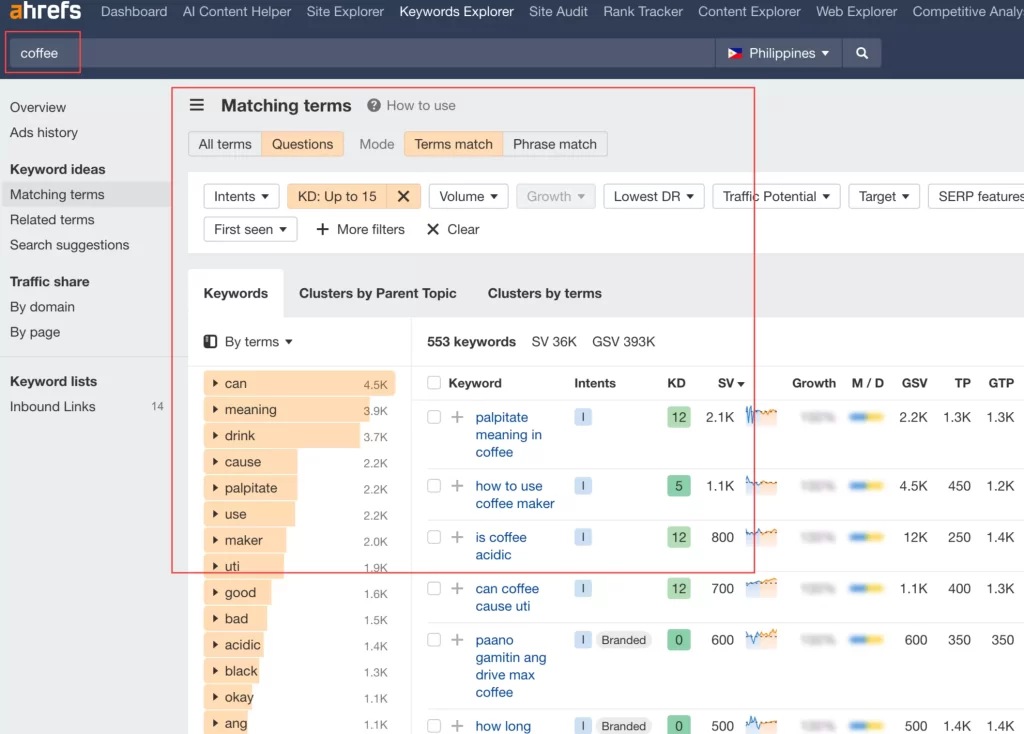
2. Find new long-tail keywords your pages can rank for.
Go to your top pages and see which content captures rankings for long-tail keywords sitting below page 1.
With a few optimizations, such as adding new sections to rank for these long-tail keywords, your content would likely increase its search traffic.
5. Publish More MOFU and TOFU Content
You don’t get sustainable rankings by expecting all product pages to rank for their commercial keywords.
One holistic content strategy is to publish informational content for keywords that lead people to their purchasing decisions.
With 15% of total searchers being new, content publishing offers an ocean of opportunities.
Start creating content to tackle comparative keywords such as “vs” or “best” phrases, which often have low competition but high traffic opportunities.
For instance, creating a blog post titled "Best Winter Jackets vs. Coats: What’s Right for You?" targets users seeking guidance while naturally incorporating relevant keywords.
Build content that answers common user questions, showcases expertise, and drives product or service page traffic. Linking these posts to collection and product pages strengthens the structure of your website and distributes link equity across pages.
Whenever you publish new content, ensure it links to related existing pages. This helps users navigate your site and signals search engines about the relationships between pages.
6. Collaborate with Active Authors
One overlooked strategy in content publishing and link building is expert collaboration.
Creating helpful content that satisfies users with new information takes a lot of work on the back end (research) and front-end publishing (editing). By getting new insights from other authors who are also practitioners in their industries, you solidify the credibility of your content piece, which increases its acceptance by your target readers.
If you don’t have any authors in mind, start reaching out to them by first populating a list of active authors in your space. You can use Ahrefs to find these active authors.
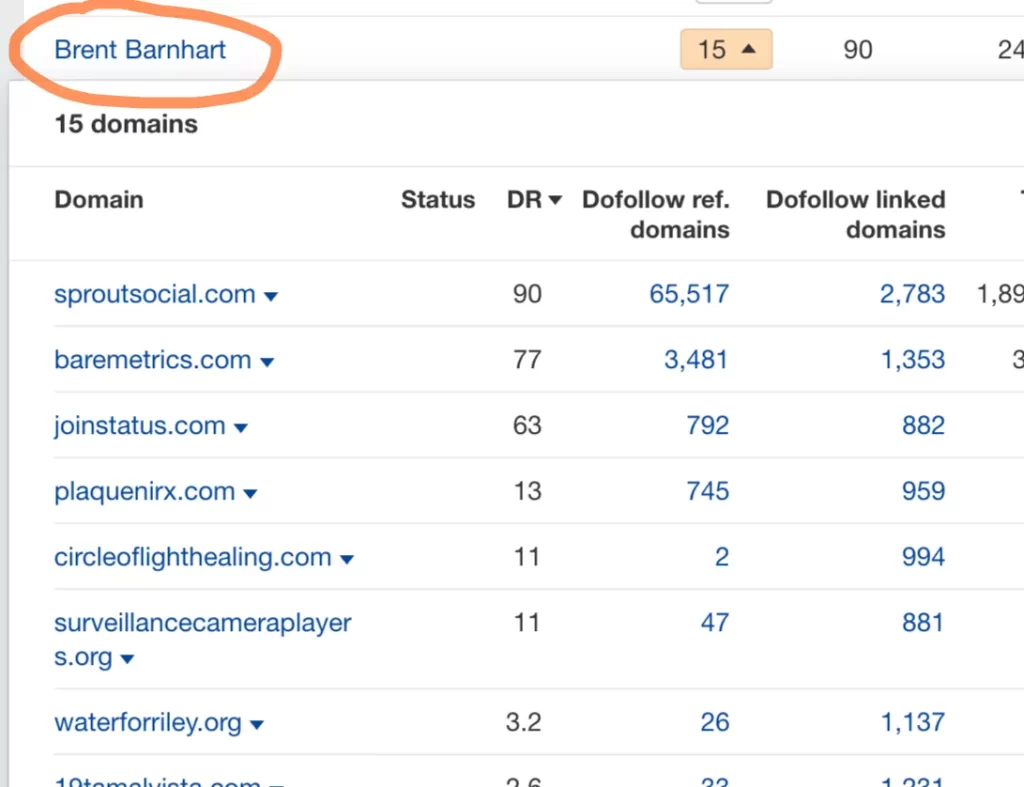
Another way is to publish “accepting guest post” or “become a contributor” pages to attract publishers to contact you for collaboration.
Obviously, not everyone is a good candidate, but getting one or two who surely know what they’re talking about is worthwhile for a content collaboration.
Fire Bullets, Then Cannonballs
SEO, in offense, must be a combination of firing bullets and cannonballs. While aiming for greater impact with high-intensive efforts, you are shooting for results with bullets—low-hanging fruits SEO. This enables you to build a solid momentum of an SEO campaign.
While everyone waits for significant results from their high-intensity work, you get consistent, quick wins with your bullets. There are small things that you can add to your SEO arsenal, giving you a head-start advantage in your competition.
Content Strategy and Link Building for Google AI Overviews
As search evolves, the rise of AI overviews in Google results brings fresh opportunities for visibility, but the fundamentals remain the same. While it’s not about optimizing content solely for AI, a strong SEO foundation enhances your brand’s presence across all search experiences, including AI-driven results.
The essentials of SEO—well-structured, unique, and genuinely helpful content—continue to be the bedrock of visibility. However, as digital marketers aiming to build authority and relevance, we can consider AI Overviews as an additional layer that increases brand exposure.
AI overviews offer the chance for brands to surface in a different light, adding an opportunity for expanded visibility in high-quality content spaces.
Content Strategy and Link Building for Google AI Overviews
Developing a solid link building and content strategy is pivotal to achieving the right positioning in AI overviews. The key to success is consistently updating content to match user intent, answering complex queries, and designing content that fulfills user needs.
1. Monitor SERP Features for Target Keywords
Monitoring SERP features helps you stay competitive. Some queries now feature AI-generated summaries, videos, images, and other multimedia elements. For example, Google may display a “People Also Ask” section, AI-generated overviews, and even knowledge panels for specific keywords.
Tools like Ahrefs, and SEMRush can identify which keywords yield SERP features, like AI overviews, that may benefit from multimedia content additions. This data enables you to adjust your content by incorporating structured data, images, or videos.
2. Creating High-Quality, User-Focused Content with EEAT
High-quality content, especially when structured for user engagement, enhances your visibility potential across search types. Google’s EEAT (Expertise, Experience, Authoritativeness, and Trustworthiness) are critical for ranking in AI-driven search.
Focus on creating original perspectives that add value (information gain), grounded in genuine expertise and real-life experience. Google’s AI algorithms identify rehashed content and can now better recognize authentic, informative resources.
Showcase your expertise by weaving in firsthand examples, studies, and insights that differentiate your content from competitors. Content that draws from expertise is more likely to rank and appear in AI-driven summaries.
3. Deep Dive into Audience Research and Core Topics
In-depth audience research is non-negotiable in aligning content with user intent and needs. Google’s ranking systems now prioritize content relevant to a website’s primary purpose. Publishing content that strays from core topics risks diminishing your authority in Google’s view.
Create audience personas to understand what your audience values. Develop content around these insights to ensure they resonate and fulfill their needs.
Ensure each piece of content addresses your audience’s pain points and challenges. If your site focuses on digital marketing, avoid publishing unrelated topics, as Google now distinguishes unrelated content sections within a site.
Google recently noted a shift in visibility for sections of sites like “Fortune Recommends” and “Forbes Advisor” due to disjointed content that wasn’t fully aligned with each site’s primary theme.
4. Link Building That Complements Core SEO
Backlinks remain crucial for reinforcing authority, yet placement has become more strategic in AI. Here’s how to build links that serve both organic search and AI-driven summaries:
- Be strategic in placing links on entities and sites you want to be topically associated with your brand.
- Consider sentiments in the context of the page's/content's overall message. Ensure they promote a more positive perception of your product/service and do not work against your offerings.
- Be on the lookout for links/resources/where-to-buy pages that can demonstrate your products' POV as they get included in the lists pages.
- Make quality control part of your process when checking the entire context of the page/content from which you aim to get links. Not only is it relevant to your site, but it must also help improve the association toward solving problems your prospective customers are experiencing.
5. Optimize Content for Complex Queries
With generative AI allowing users to ask intricate questions in one search, optimizing for query chains—consecutive follow-up questions—is more effective than targeting isolated keywords. By addressing connected topics, your content appears more thorough and relevant.
Write comprehensive guides that anticipate follow-up questions. For instance, if you write about “digital communication skills for HR,” also consider covering “how digital skills benefit talent development” or “common challenges HR faces in digital communication.”
By structuring content with linked topics, you increase the chances of AI identifying it as useful for multi-layered searches.
6. Publish Short-Form Videos Directly on Your Site with Structured Data
While platforms like TikTok, Instagram, and YouTube are popular for short-form video content, don’t overlook the value of hosting these videos on your website. Tools like Wistia can enhance video quality and user experience on your site.
By embedding videos directly, you keep traffic on your domain and have better control over the content’s SEO impact. Additionally, mark up your videos with structured data to make them more discoverable in Google Search and eligible for inclusion in AI overviews.
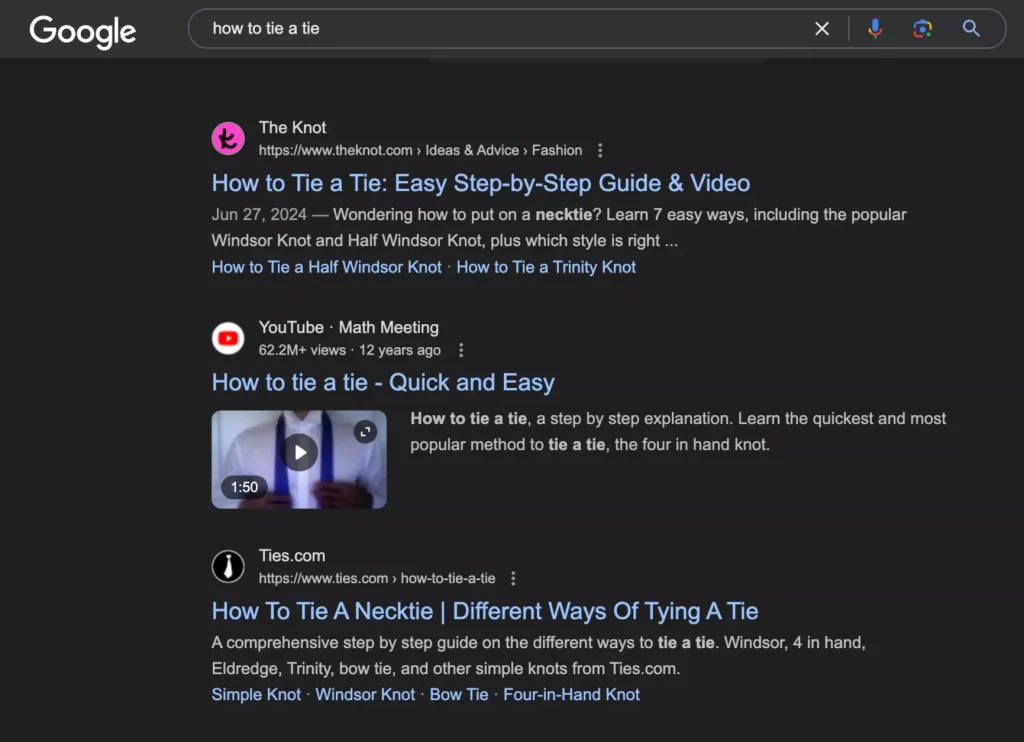
Embed product demos, explainer videos, or testimonials directly on relevant landing pages and use structured data to signal their relevance to Google. This can improve visibility in both standard search results and AI-driven summaries.
7. Enhance Sales Pages with FAQs and FUQs (Frequently Unanswered Questions)
Adding FAQs to your sales pages immediately answers common customer questions, enhancing user experience and optimizing for AI overviews. FUQs, or frequently unanswered questions, address nuanced or lesser-known queries, showcasing your in-depth expertise and understanding of the customer journey.
Identify customer pain points and unique questions that arise during the sales process. Incorporate FAQs and FUQs into your content strategy to address these needs proactively. This thoughtful design positions your content as a comprehensive, reliable source in current search results and evolving AI landscapes.
Positioning Content for Future Search Landscapes
Incorporating these practices prepares your content for success in an evolving SEO landscape, where AI-driven summaries may soon become more prominent. By blending traditional SEO with AI-conscious content practices, you build an adaptable content strategy that remains resilient in a changing environment.
The essentials—quality content, strategic link building, and user-focused design—create a content approach that thrives in AI and traditional search results, establishing your brand as a trusted source.
Types of Backlinks That Impact Your SEO (and How to Get Them)
Link building has always been one of the most challenging areas of SEO.
It will get more difficult these days, especially in highly competitive spaces, as most Google core updates and HCU updates strongly favor brands (sites with stronger link profiles, brand searches, and mentions from reputable sites), emphasizing the need for better types of backlinks.
The notion of getting only quality links doesn’t apply in ranking sites today. Link building should be about getting more quantity of the quality links that count.
Google’s algorithms are smart enough to distinguish between a high-quality editorial mention and a spammy, low-value link. Focusing on quality links alone won’t make it. You have to acquire more to maintain rankings and strengthen brand positions.
The links you aim to build should meet at least these two primary criteria:
- High-quality: Links from authoritative, relevant sites within your industry.
- Hard-to-replicate: Links that your competitors cannot easily reproduce, giving you a competitive advantage.
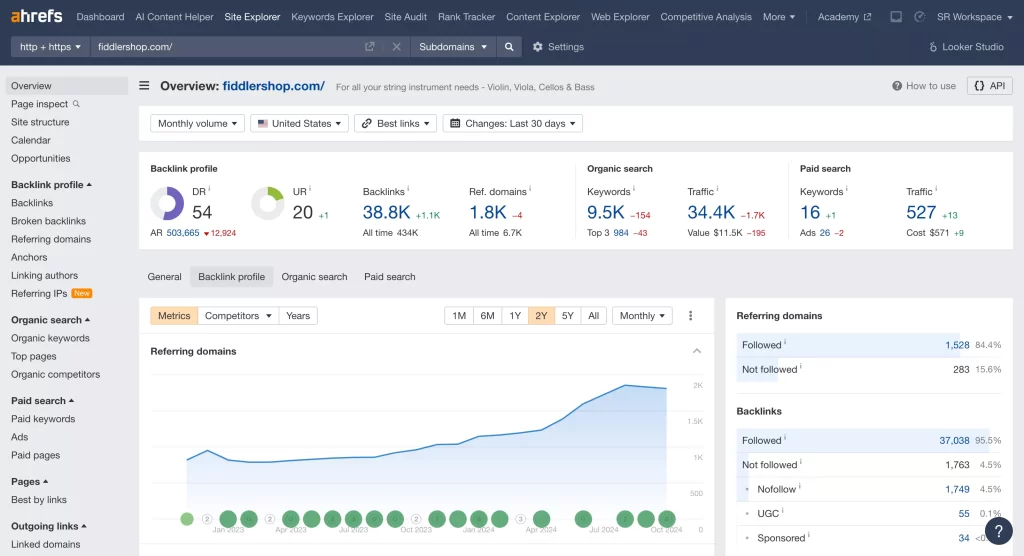
So, what are the types of backlinks that matter today?
1. Editorial Links
Editorial links are highly coveted because they signal authority and trust. These links come from natural mentions in articles, blogs, and other media without a direct request from you. Earned links through strong content, positive press coverage, or expert quotes are strong indicators that people trust your site, which helps your pages climb higher in Google’s SERPs.
Why They Matter:
- They are seen as the most organic form of a backlink, showing that other authoritative sources value your content. These links are referential in nature and could only be acquired if you have great content published on your site or if you have a link-worthy product.
- They help position your brand as a leader in your industry. Editorial links from reputable sites can serve as social proof and enhance your thought leadership.
- Drive referral traffic from reputable sources, increasing the likelihood of converting visitors into leads or customers. When other publishers recommend your product/service through links, it’ll help assist conversions.
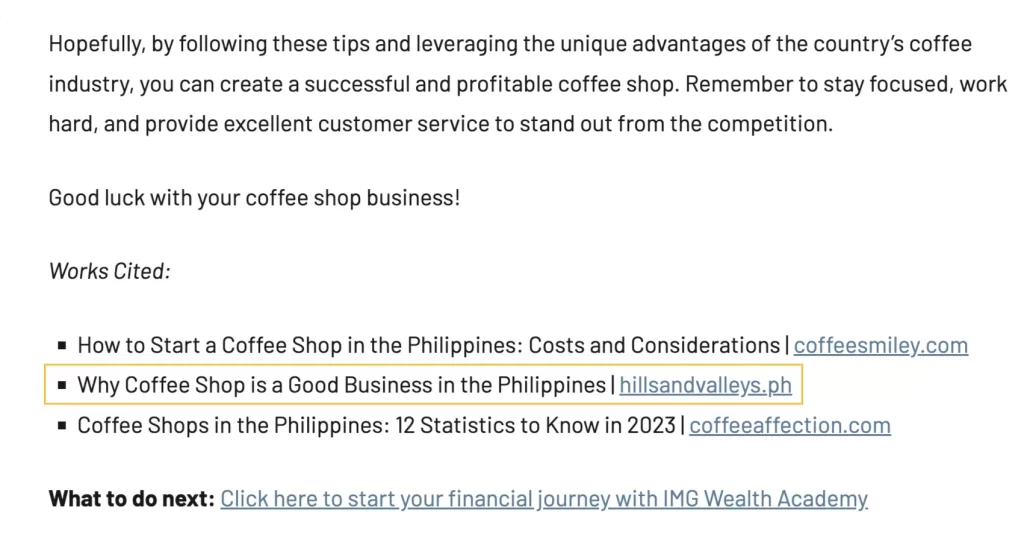
How to Get This Type of Link?
- Publish High-Utility Content Assets: Create content that fills a knowledge gap in your industry, such as in-depth guides, unique case studies, or proprietary research. Content that educates or provides a solution naturally attracts editorial links. In today’s age, providing new information (“information gain”) is critical as it attracts established authors who are looking for new bread of industry information for their audience.
- Leverage PR: Use media outreach to promote new products, reports, or expert opinions that could be picked up by publications or influencers in your field. Subscribe to Mark Rofe here, as he shares actionable regular tips on how to utilize digital PR to its fullest.
2. Links That Drive Second-Hand Traffic
These backlinks come from niche forums, community discussions, or recommendation pages, and while they may not carry the same SEO weight as editorial links, they’re highly valuable for driving targeted, second-hand traffic.
It is usually known as second-hand traffic, but it doesn’t diminish its value. The traffic that comes from recommendation and community sites is as powerful as editorial links.
Why They Matter:
- Links from community-driven sites (such as niche forums or “how-to” pages) often bring users who are further along in their decision-making process. These visitors are more likely to convert as they arrive at your site already looking for solutions or recommendations.
- They create diversified traffic streams, making your site less reliant on organic search traffic.
How to Get This Type of Link?
- Engage in Niche Communities: Participate in niche forums or communities where your target audience hangs out. Contribute genuinely by sharing insights and solutions, which can lead people to link to your site as a resource. Pro Tip: Don’t try to push hard on your product recommendations if they are not relevant. It would otherwise backfire on your brand if you do so.
- Provide Solutions on Q&A Sites: Sites like Quora or Reddit can be goldmines for getting these types of links. You can gain backlinks and traffic from these platforms by answering questions and providing value.
- Invest as much time to see opportunities further. When there are opportunities to add value with your product recommendations (as authentic and as useful as they can be), don’t hesitate to answer in the discussions.
3. Links From Ranking Pages
Links from pages that already rank well in search results carry a unique value. These pages receive a constant flow of organic traffic via rankings, and the authority from their position in the rankings can pass on to your site.
I see it as banking on other pages’ authority, as these pages may be seen as relevant to certain queries I may have wanted to rank for either informational or commercial keywords.
Why They Matter:
- Ranking pages are highly authoritative in the eyes of search engines, so a backlink from them holds more weight.
- They ensure a steady flow of referral traffic, as users continually find these pages through search.
- These links often come from content that is highly topical relevant to your site, further boosting your rankings in specific keyword niches.
How to Get This Type of Link?
- Outreach to Ranking Sites: Identify sites that rank well for your target keywords, and offer value through guest posts or content collaborations through SEO outreach. Focus on content that enhances their ranking pages, like providing an expert opinion or data that complements their existing material. Make sure you’re adding unique information that isn’t yet found on the page to increase the likelihood of getting your pitch noticed (and hopefully acquiring the link from the page).
- Get Included in Listicles: Reach out to sites that create “best of” or “top X” lists related to your niche. Offering a compelling reason why your product or service should be included can earn you a spot on these high-traffic pages. See which angles or unique POV your products or services could offer that would be irresistible to add to the page.
4. Contextual Links from Distributed Content
Contextual links embedded within relevant content (such as guest posts, listicles, or interviews) are highly valuable because they integrate naturally into the flow of information and provide search engines with strong context about your site’s relevance.
Compared to reaching out to get added, you need a compelling reason—a content piece that adds new information to the industry’s knowledge base—to have a chance for link placements.
Why They Matter:
- Contextual links within content carry more SEO weight than sidebar or footer links because they are part of the main content, signaling to search engines that they are directly relevant to the topic.
- These links also tend to drive better referral traffic since they appear organically as part of an informative resource.
How to Get This Type of Link?
- Guest Posting on Targeted Sites: Focus your guest blogging efforts on sites that serve your intended audience. Aim to provide content that adds value and is relevant to the readers of those sites. Pro Tip: we use Ahrefs’ Domain Rating (DR) and SEMRush Traffic to see if a potential publisher is worth contributing content to. Benchmark must be Ahrefs’ DR 25 and above, and with existing organic traffic of 1,000, and without history of traffic drop (or algorithmic penalties).
- Leverage Your Author Portfolio: If you’ve built a portfolio of high-quality content, use authorship as leverage to contribute to reputable sites with high Domain Ratings (DR). Match your contributions to your professional profile, which increases your chances of landing a contextual backlink on relevant sites. Pro Tip: If you’re working with SEO clients, you can use thought leaders or in-house experts in the company who want to build their personal brand. Collaborate with them by assisting them in doing the outreach yourself and letting their content be submitted with links to their personal site and your client’s site.
5. Thought Leadership Links
Thought leadership links come from opportunities such as public speaking, podcasts, and interviews. These links establish your authority in your niche and extend your digital footprint beyond written content.
Why They Matter:
- Links from organizations or events where you’ve presented establish you as a thought leader and build credibility not just with search engines but also with your audience. They also help your site optimize for large language models (LLMs) like ChatGPT, Perplexity, and AI Overviews, which rely on information from other publishers.
- They can diversify your backlink profile by incorporating non-traditional SEO sources, making it harder for competitors to replicate. This type of backlinks require depth of expertise and personal brand to garner a chance.
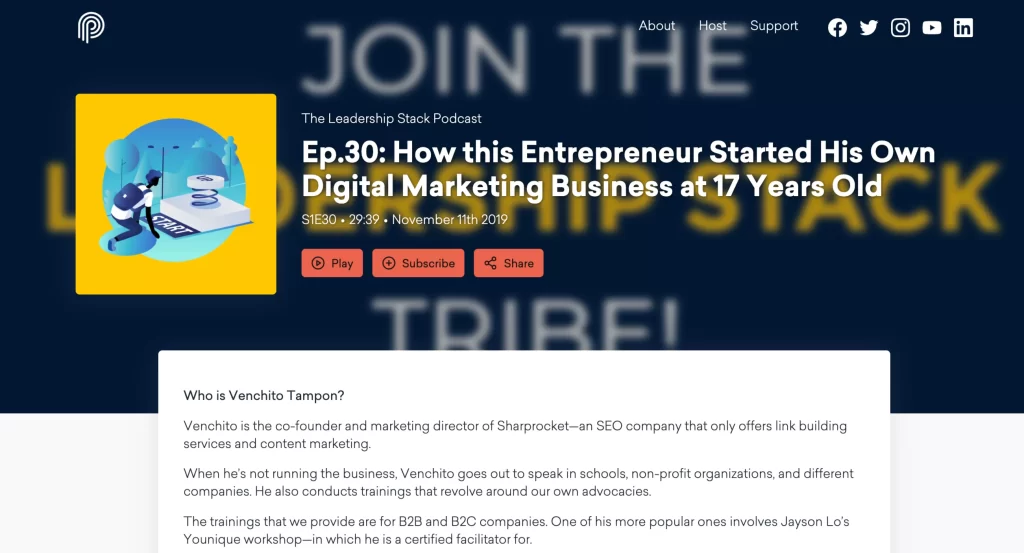
How to Get This Type of Link?
- Guest Speaking: Look for opportunities to speak on podcasts, at conferences, or in webinars. This builds your authority and earns you backlinks from the event or podcast host’s site.
- Leverage Personal Interests: If you have interests outside of your professional domain (e.g., personal development, productivity), use these as angles to land guest spots on podcasts or content collaborations outside your main niche. These can still drive relevant traffic to your site. For instance, I do corporate training on topics related to personal development, leadership, career, sales, and customer service. This allowed me to diversify my approach to guesting that other SEO and digital marketing speakers can’t easily access to unless they have similar personal interests.
6. Product-Led Links
Product-led links are earned by offering valuable tools, templates, or services that can be highly utilized by targeted audiences. They act like an extension of a first-touch experience, as they get to have immediate access to premium features your tools provide.
Why They Matter:
- Offering no-cost products like calculators, checklists, or apps can generate consistent backlinks because these resources are highly shareable. It also helps potential customers convert, as they get to experience first the value before making a purchasing decision.
- These backlinks are sustainable since they continue to attract new links as more users discover and share your product.
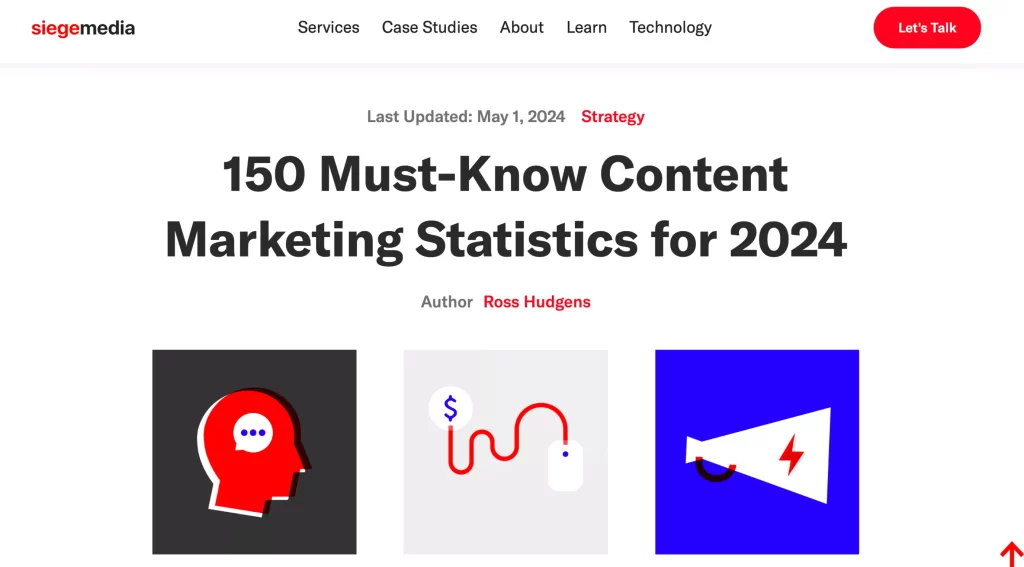
How to Get This Type of Link?
- Develop Free Tools or Resources: Create high-utility resources like free templates, checklists, or tools that your target audience finds useful. Distribute them through your site or platforms like Product Hunt to get the word out.
- Ask your networks in the industry to share your new tool or resource: Send emails to friends and networks in your space to gain early traction for your product-led content assets.
- Outreach to Resource Pages: Actively promote your tools or services to websites that curate lists of free tools. These pages often attract significant traffic and can generate long-term backlinks.
Get The Type of Backlinks That Count
Not all backlinks are equal in SEO value, and understanding which types of backlinks move the needle for your business is crucial.
Focus on building hard-to-replicate, high-quality links that enhance your authority, drive traffic, and generate leads.
Whether it’s through editorial mentions, contextual links, or product-led backlinks, prioritizing quality over quantity will lead to more sustainable SEO success.
SEO-Driven Content Marketing For Startups
Create content that ranks and converts.
SEO-driven content marketing aims to rank pages and engage users so that they will convert.
While most SEOs vouch for just rankings, I do believe that content marketing activities should impact the business goals and objectives ─ and any marketing activity, for that matter.
In this guide, we’ll explore tips on utilizing content marketing for startups to drive SEO impact to your website.
1. Turn Audience Research to Content Clusters
Start by understanding the needs, interests, and challenges. This can involve creating a buyer persona that speaks to the demographic and psychographics of your target audience. Getting fresh data from your management team can also help pinpoint who your customers really are.
Create your ICP (Ideal Customer Profile), which describes your business' ideal customer based on common attributes like demographics, behavior patterns, needs, and pain points.
Then, use tools like Sparktoro or Ahrefs to discover topics and questions your ideal customers might be searching for to find solutions.
When looking for topics, ensure you tap into each stage of the marketing funnel (Awareness, Interest, Desire, and Action), or in the digital marketing realm, we have BOFU (bottom of the funnel), MOFU (middle of the funnel), and TOFU (top of the funnel).
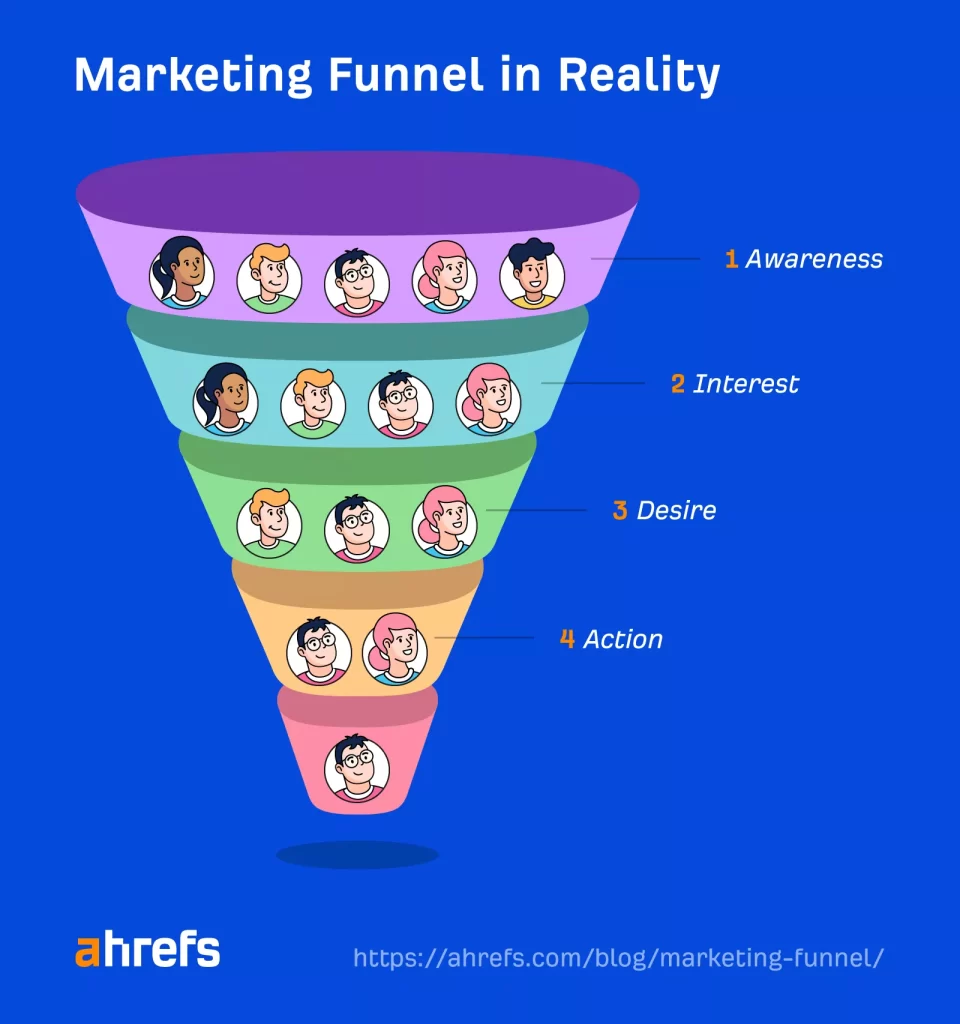
Even if it’s not a product/service page you’re publishing, you can still convert customers on your pages in the TOFU funnel (informational pages) as long as you deliver solutions to their needs and contextually place a solid call to action on your landing pages.
Here are a few steps to building effective topic clusters:
- Identify Core Topics: Identify 3-5 broad topics that align with your startup’s services, products, or expertise. These will become your pillar pages.
- Conduct Keyword Research: Use tools like Ahrefs, SEMrush, or Google’s Keyword Planner to find relevant keywords related to your core topics with significant search volume. Pro Tip: Do not skip zero-volume keywords that must be part of your content marketing base.
- Create Subtopics: Based on the keyword research, identify subtopics that address various facets of the core topic.
- Link Your Content: Interlink your pillar page with cluster pages. Internal linking helps search engines better understand your priority pages and improves the crawling and indexation of your new pages.
For instance, If your startup offers project management software, your pillar topic could be "Project Management Techniques". Cluster pages could cover subtopics like "Agile Methodology”, "Kanban vs. Scrum”, and "Project Management Tools for Startups”.
Publishing these product-led linkable assets can also lead to more link building opportunities while driving new users to your product or service.
2. Enlarge Your Publishing Base Through People-First Content
People-first content is about creating valuable, relevant, and high-utility content that meets the needs and expectations of your intended audience.
We’ll examine these four critical components of people-first content (Jason Acidre’s framework).
Needs Met
“Needs Met” is about how well your content matches the searcher’s intent and fulfills their expectations. Here’s how to ensure that your content meets this criterion:
- Intent Matching: Ensure your helpful content answers the exact queries your audience is searching for. Use tools like Search Console to identify common keywords and adjust your content to fulfill informational or commercial intent. Avoid misleading click-bait titles that don’t deliver on their promises.
- Target a Single Topic & Intent: Focus on a single topic, providing clear and concise answers without overwhelming the reader. Avoid burying essential information in long, multi-topic content. Consider using separate pages for subtopics with significant search volume.
- Direct Answers to Main Queries: Present direct answers prominently above the fold using formats like Quick Answer Boxes, Key Takeaways, or Summaries. This approach caters to users seeking quick information, especially on mobile devices.
- Remove Fluff Content: Keep your writing concise and relevant, eliminating off-topic, redundant, or overly wordy sections to maintain clarity and improve user experience.
For instance, in every blog post I write for our corporate training blog at Rainmakers, I determine the user intent of each search query. Asking the question, “What do they want to know first?” helped me prioritize points (and put them above the fold) so it would immediately satisfy the user's needs.
Here’s a recent post on “What is leadership to you?” The searchers would likely be students and learning and development practitioners who are looking for different schools of thought on the subject.
I delivered what they needed, based on my expertise on the subject:
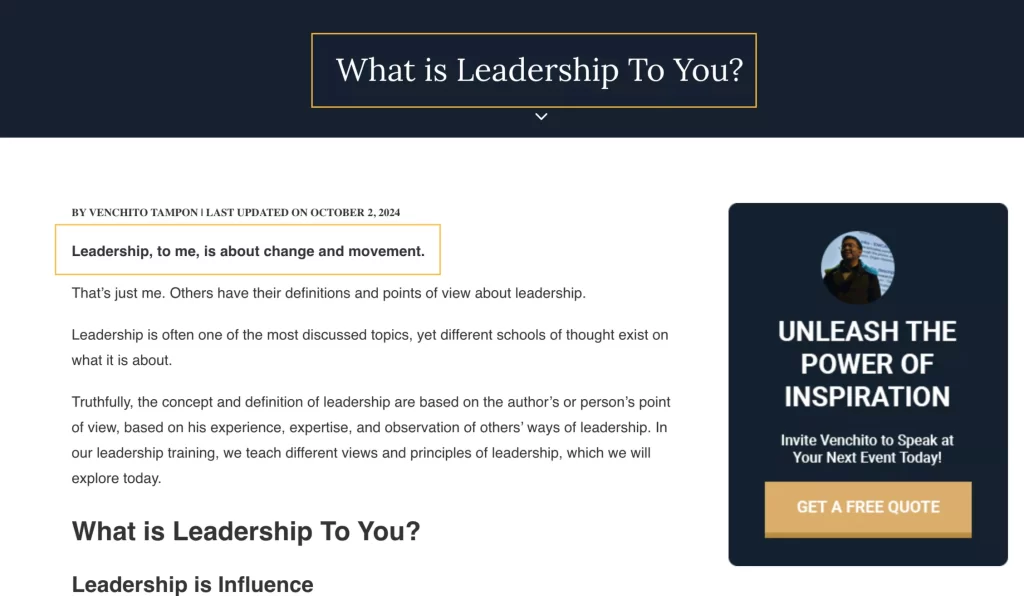
Another example is my coffee shop blog. We meet users’ needs by providing direct answers to certain questions (e.g., how much does it cost to start a coffee shop?).
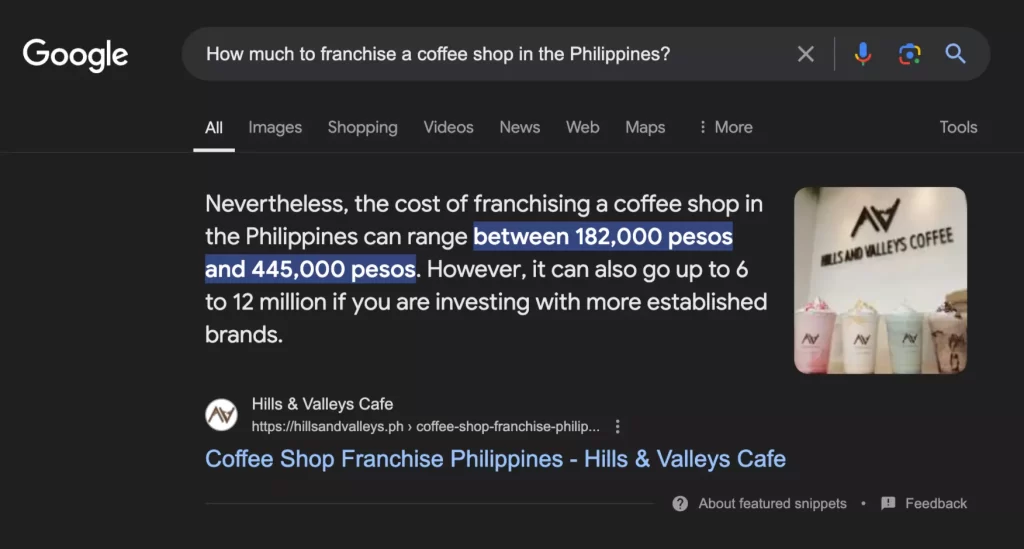
Now, this brings us to the next component of creating people-first content:
EEAT (Expertise, Experience, Authoritativeness, Trustworthiness)
By now, we should have known this populating all over SEO blogs. The ability to integrate EEAT into your content matters ─ here are few tips to leverage this:
- Comprehensive Author Details: Showcase the author's experience, expertise, education, achievements, and social media links to showcase their credibility (authorship SEO). A detailed bio builds trust and authority.
- Proper Sourcing & Citations: Cite reputable sources to demonstrate that your content is research-based and factual, enhancing trustworthiness and depth.
- Including Credible Stats or Expert Quotes: Incorporating statistics or expert quotes can boost content visibility and authority by 30-40%, providing evidence-based information that supports your claims.
- Accuracy of Information: Ensure your content is accurate, especially for industries like YMYL (Your Money, Your Life). Update facts and data regularly to maintain integrity and ethical standards.
- Editorial Process, Disclaimer, and/or Disclosure Statements: Include disclaimers, disclosures, or editorial policies to add transparency, authenticity, and clarity about the content’s intentions or potential biases.
Ahrefs has solidified its brand marketing by incorporating credible authors and experts to contribute insights and quotes to its blog posts, boosting the pages’ credibility and search performance.
Originality & Information Gain
Google emphasizes originality and information gain to combat the issue of copycat content. The goal is to provide unique insights that add value beyond existing content. Here’s how to enhance originality:
- First-Hand Knowledge: Share personal experiences, unique insights, or innovative ideas that address unmet needs. This will set your content apart and position your brand as an expert, potentially earning hard-to-replicate DR 90 backlinks.
- Original Research & Data: Conduct your research or gather data through surveys, experiments, or analysis. If you can't collect data, source it from public databases and present it from a unique angle to offer fresh insights.
- Provide Self-Sourced Images: Use original visuals like screenshots, branded infographics, product photos, or personal experience images to add authenticity and relatability. This makes your content more trustworthy and distinctive.
When incorporating experiences into your content, include what made you feel, see, touch, and taste ─ these are five senses only a person with actual experience on the topic can share in the content.
Give Depth To Your Content Assets
One of the WOSCON 2024 speakers, Kasra Dash, mentioned during the panel Q&A that building topical authority on a website requires publishing more pages within a relevant subject and achieving depth through topics that haven’t been published elsewhere.
Identify subtopics that could be expounded into single blog posts. Based on your expertise and experience, think of topics you can add more depth by giving more information on the “how-to” or new insights from real-world practice.
You can also publish internal data studies that align with topics to validate and support points. This is also an additional content asset that attracts new links to your page.
3. Build a Link-Earning Flywheel
Link building through manual outreach is becoming more difficult these days. Asking for inclusion or requesting a link requires newly contributed content and a solid reason for linking.
This is one primary reason why building a link-earning flywheel on your site gives you leverage to earn passive links without the constant need to do email outreach.
Here are a couple of ways to build a link-earning flywheel:
- Invest in ranking content assets for informational queries other publishers are searching for when looking for additional resources to reference in their content work (e.g., how-to, statistics, data, etc.).
- Provide direct answers to posts’ FAQs and industry questions to get featured snippets.
- Create high-utility content like tools, calculators, or quizzes that intently help solve your target customers' problems.
- Engage in thought leadership. Participate in webinars, podcasts, or industry forums to establish authority in your space and attract publications that will link to your insights or expertise.
4. Brand Positioning via Content Promotion
Contributing content to other sites in your industry positions your brand from a place of authority, as you provide new insights that can add to the body of knowledge in your industry.
Here are ways to position your brand through content promotion:
- Promote your content assets by linking to them from content you distribute on other blogs (i.e. guest posts).
- Create media lists for your digital PR campaign and build relationships with journalists and publishers. If you receive requests and notifications for expert quotes, have your client respond to them (as they’re likely to get a positive response).
- Use Ahrefs to find pages with many links (>100). Create something better and pitch as a replacement.
This link-earning flywheel generates momentum over time, as quality content attracts new backlinks, and these linking pages also attract links on their own.
5. Maximize Rankings for Low-Hanging Fruits
Low-hanging fruit are keywords that are easier to rank for and can quickly increase traffic to your site. Optimizing content for these keywords can help your startup gain quick wins and establish your brand authority to tackle more competitive search terms.
Here’s how to identify and leverage low-hanging keywords:
- Use tools like Ahrefs, SEMRush, and Google Search Console to find keywords you’re already ranking for but aren’t in the top positions (e.g. position 5 to 20). These are opportunities where a little optimization efforts can significantly improve rankings.
- Target low-competitive long-tail keywords. For instance, you can write more specific topics like “best solo travel destinations in Southeast Asia” or “affordable family vacation spots in Europe” instead of targeting “travel destinations.”
- Optimize and upgrade existing content to include low-hanging keywords (discovered through Search Console or Ahrefs). Update headings, meta descriptions, image alt text, and internal links to reflect the targeted terms.
This strategy works because it allows your startup to achieve quicker SEO results. As you gain more authority and organic visibility, it helps you dominate other terms, mainly commercial queries, which brings additional revenue.
How to Get DA 90 Backlinks in 2024
Securing backlinks from high-authority websites can be a game-changer if you aim to rank for highly competitive keywords in Google’s SERPs.
Sites that can provide you with Domain Authority (DA) 90+ backlinks, in particular, are among the most powerful backlinks you can acquire, as they come from sites that Google views as highly credible and trustworthy.
In fact, having a few DA 90 backlinks when you’re just initiating a link building campaign could provide significant results to its destination page—we’ve seen it happen with our own web properties and clients in our link building agency.
In this article, we will explore proven strategies for securing those coveted DA 90+ backlinks, which will give your website an extra boost to outrank the competition.
1. Get Product Links from Comparative Pages
This product-led link building campaign aims to effectively dominate the top page of Google’s SERPs by being as visible as possible. By ensuring your product is featured on multiple comparative pages, you create a multi-touchpoint strategy where potential customers encounter your brand repeatedly while researching solutions.
Comparative pages, such as “Top 10 Healthcare CMS Tools” or “Best POS for Restaurants in the Philippines”, help readers compare different products or solutions within a niche. They often get the most search traffic by ranking for investigative queries.
Aim for inclusion from these pages as you reach out to the authors or website owners. You can offer a trial or free access to your product so they can experience it firsthand, making it easier for them to include your product with a genuine recommendation.
If link inclusion is not possible, identify a niche segment in which your product could be considered the top choice, as it delivers the most value compared with other solutions.
Identify high-authority websites that frequently publish comparison articles in your niche. You can use Ahrefs to find these pages with DA90+ sites quickly. Contribute a comparison article featuring your product as a go-to choice for a niche segment solution.
2. Podcast Mentions Using Podscan.fm
Podcasts are an increasingly popular platform for thought leadership and offer an often-overlooked avenue for acquiring high-quality backlinks.
They are a robust arsenal for brands that attract multiple guests for their personal stories and expertise.
You can use Podscan.fm to monitor all podcasts for mentions of you (as a personal brand) or your company. It sends alerts if you get a new mention.
I tested this out by entering a marketing thought leader, “Mark Schaefer".
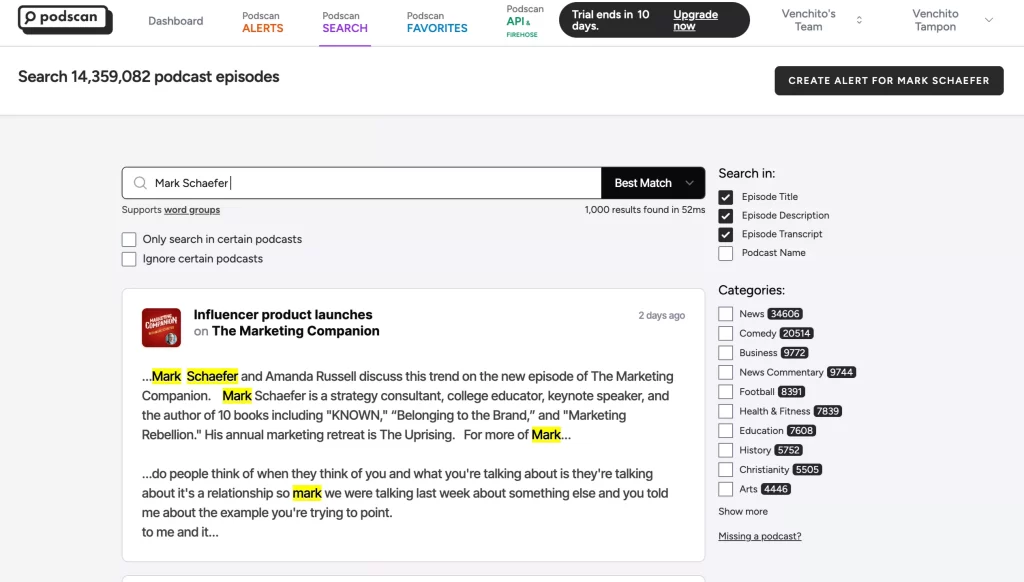
Another way to leverage this tool is to identify podcasts that feature either competitors or non-competitors in your niche or industry.
Reach out to hosts with a pitch on why they’d want you to be a guest. Highlight your credentials, expertise, and unique insights. Once featured, provide the host with a list of links that are included in the show notes, such as links to your website, articles, or resources that offer additional value to their listeners.
3. Recurring Links From Content Partnerships
If you've been following the SharpRocket blog for a while, you’ll notice I’m a strong advocate of content partnerships.
The strength of this link building strategy, compared to other forms, is that it isn’t easy to replicate by your competitors. Content partnerships require access to relationships and collaboration—obviously, anyone cannot manufacture relationships.
Content partnerships can also drive recurring links instead of a one-time link from a unique domain. While most SEO authors vouch only for getting as many unique referring domains, having recurring links from DA 70 sites helps you build more trust signals to your site.
Start getting recurring links by offering to cross-promote each other's content assets through reciprocal link building—linking to highly relevant pages. If your site has a lower DA than the site you’re proposing to, you can use other angles or resources to match the partnership—it could be sharing the link to your newsletter or social media platforms.
The key to success in a content partnership is always determining how to bring the most value to the other party.
Another approach is co-authoring in-depth guides or reports, where you and the partner site share expertise. This leads to mutual backlinks from their high-DA site and future inbound link opportunities from other authoritative sources linking to the content asset.
4. Utilize Digital PR Campaigns
Digital PR has been an integral part of SEO campaigns for creative SEO agencies today. It leverages newsworthy content or stories to attract attention from high-authority sites, earning DA 90+ backlinks.
Unlike traditional link building, where it heavily relies on the efficiency and impact of outreach campaigns, digital PR focuses on the credibility of the content, its uniqueness, and timing in building relationships with journalists and influencers who can amplify your content.
I’ve covered this in our previous guide on digital PR best practices, but let me share more meat to it:
- Create compelling, data-driven, or unique stories that include original research, survey results, expert commentary, or thought-leadership articles. Having content related to your product offerings is a plus; this can lead to more product-led links that assist you in achieving your business goals.
- Use PR tools like Qwoted, Help a B2B Writer, and Connectively to connect with journalists looking for exclusive content or expert insights in your niche. Respond quickly with the correct information to get quoted in their articles.
- Maximize new product launches or industry insights in developing press releases for significant announcements, as brands with creative online launches can catapult to many DR 90 backlinks.
5. Product-Led Content Assets To Earn .Edu Backlinks
Offering scholarships to get .edu backlinks has been a staple link building technique in the industry. Getting scholarship links from a scholarship list page with hundreds of external links to various scholarship programs is getting lesser in link value.
The way to go forward in earning .edu backlinks is by producing content assets that address audience needs while demonstrating how your product or service can solve users’ problems.
To achieve this, you can create in-depth, authoritative guides, tutorials, or research-based content highly relevant to educational institutions. For instance, you might create a guide on emerging technologies that interest computer science departments. It could have a tool section where one of your products can be an obvious solution.
Reach out to university librarians or student resource coordinators who offer your guide as an additional valuable resource for their students or faculty.
Consider creating resource pages designed to complement a university’s curriculum, making it easier for them to link to your comprehensive guide.
Does your brand need high DA backlinks? Contact us to discover link building services to improve your site’s ranking and overall search performance.
Link Building Prospects Approval: Streamline Your Process for SEO Success
Link building prospects approval is one of the overlooked aspects of link building, yet it is the determining factor that separates a successful link development campaign from mediocre ones.
Assessing backlinks based on quality, trustworthiness, and potential impact on website traffic and business objectives empowers your SEO campaign to achieve both its quick wins and long-term goals.
You could have thousands of link prospects, but without a strict quality control process, you’re likely to acquire irrelevant or low-value links that will not increase your site’s organic traffic.
Essential Criteria for Evaluating and Approving Link Building Prospects
The primary question, especially for SEO beginners, is, “What should I consider when evaluating backlink prospects?”
The quick answer to this: topical relevance, quality of the site’s backlink profile, engagement, and targeted traffic sources.
James Norquay has shared a recent experience of one of the backlinks acquired by an SEO agency to a client.
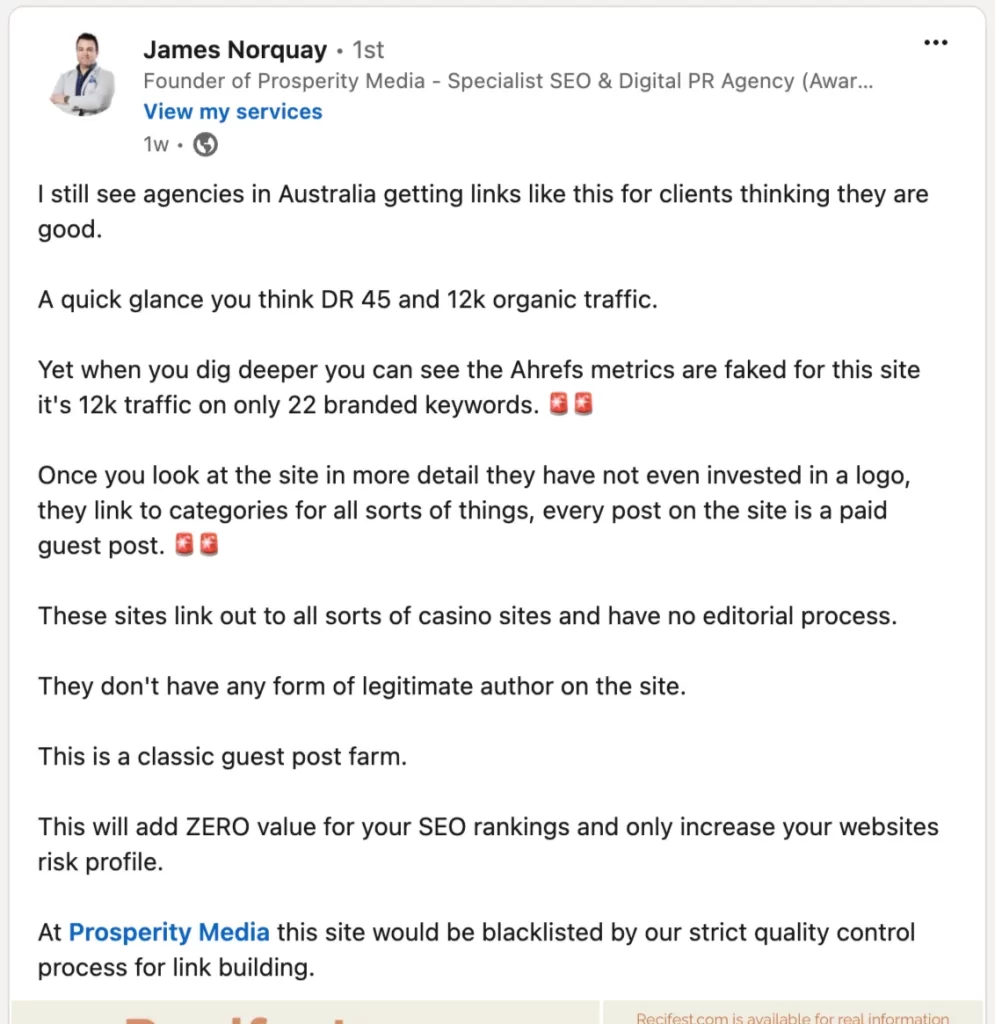
Those examples (and types of links) will not improve the client’s SEO rankings and could risk the site’s link profile.
Our link building agency has a simplified yet strict backlink qualification process. We do it pretty much manually (with the help of a few link analysis tools to quickly determine either the page or site authority score).
Link qualification will vary from industry to industry, the content assets available and their context. But essentially, these criteria are a solid list of control measures.
Site Legitimacy and Branding
When assessing backlink prospects, it is crucial to examine the site’s legitimacy and branding. A quick review of the website’s visible elements—such as its design, logo, social media profiles, About Us page, and Contact details—provides clues to whether an established entity genuinely owns the website.
Another way to confirm the site’s legitimacy is to check its blog author or contributors page, legal disclaimers, and history of consistent content production. These indicate a serious established presence in its niche.
For some instances, you can run the main author picture in Google Reverse Image search to see if the images used have been downloaded from stock photo websites.
Topical Relevance
Topical relevance in the scope of the target customer base is an essential factor in link building decisions.
Make sure the site’s content aligns with the industry or niche to ensure that the links obtained will be contextually appropriate.
Fact to tell that Google’s algorithms reward relevant links, so make it a top priority to choose sites whose topics closely relate to your own. Review their blog posts, product pages, and overall theme to verify that they consistently cover topics that naturally link to your website.
Quality of Website’s Backlink Profile
Evaluating the quality of the website’s backlink profile provides insights into its authority and trustworthiness. Link analysis tools like Ahrefs and Moz can help assess the strength and diversity of a site’s backlinks.
Check for anchor text usage, especially if it is mostly natural or branded, to avoid sites involved in link farms. You can check 3 to 5 recent articles or blog posts and click on some internal and external links.
Avoid sites that primarily link to spammy, unnatural, low-quality sources or from high-risk niches like casino (unless you operate in those verticals), as these can negatively impact your site’s SEO efforts. Instead, focus on prospects with a strong, reputable backlink profile that reflects credibility and authority within the domain.
You can filter links based on the default Ahrefs’ Best by Links feature—dofollow, in content, DR30+, and Traffic of 500+ (or customize based on your link benchmarks).
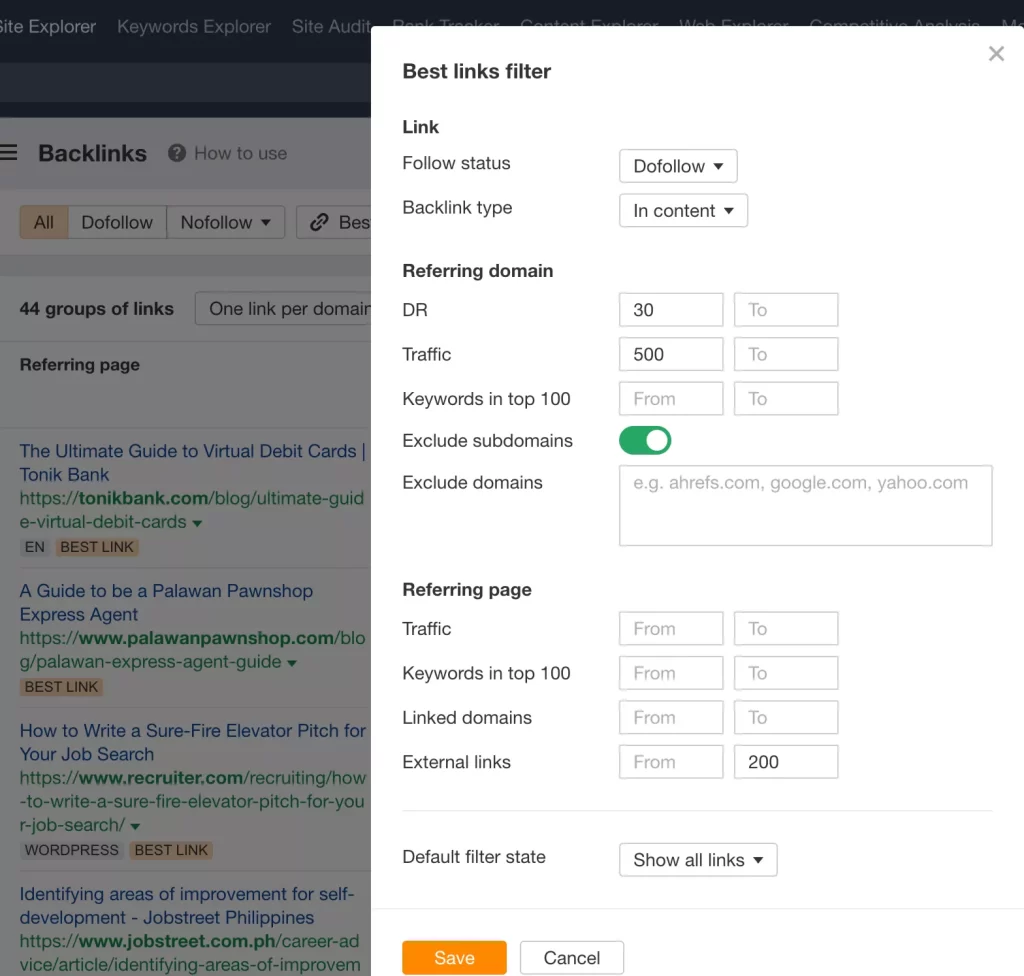
Targeted Traffic Sources
Understanding where the site’s traffic comes from can help you determine whether you’re likely to get additional value in the form of referral traffic as you acquire the link.
If you’re trying to rank for search results within the APAC region, evaluate domains if the traffic primarily comes from related countries such as Singapore or the Philippines.
A well-targeted site will have a steady flow of traffic from search engines, and relevant sources are more likely to drive qualified visitors to your site when the link is placed.
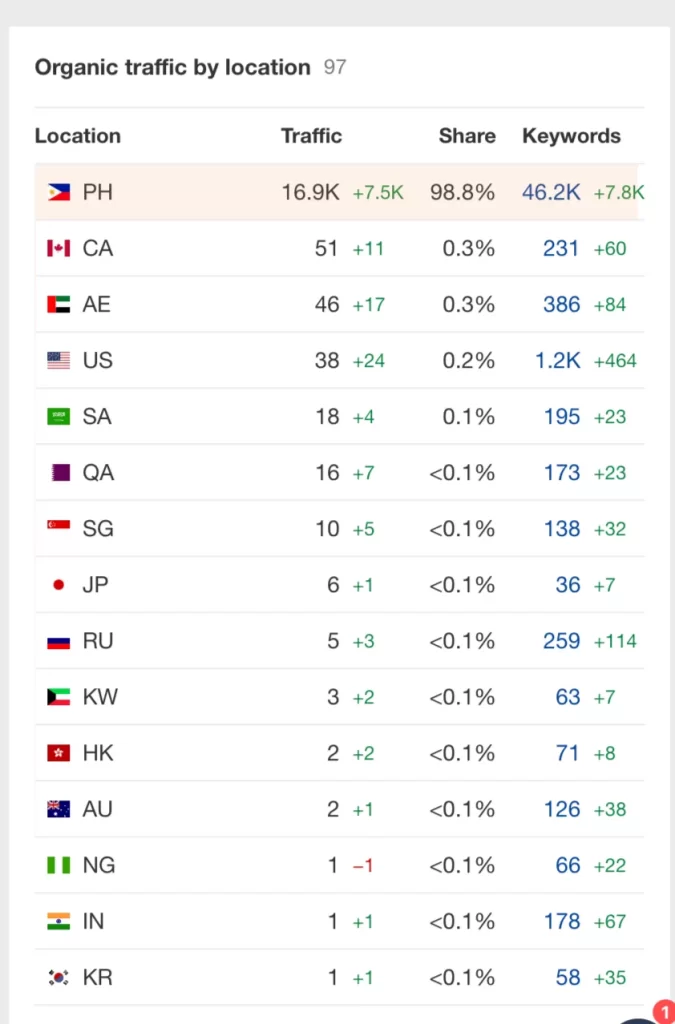
See the traffic graph if pages dropped in traffic—it could indicate that the site got hit by penalties. While a few sites recovered in the recent Core Update, most domains didn’t have the expected light of the day, so double-check for any traffic drop.
Prioritize sites with targeted traffic that aligns well with your audience, as it can boost the chances of gaining relevant referral traffic.
Optimization Tips to Improve Link Building Prospects Approval
Having a diverse set of link building clients allows us to optimize our process to get more approved prospects. By working with different industries and brands, like our SaaS client with strict guidelines or an eCommerce brand targeting niche markets, we customize our approach to meet varying requirements.
Our adaptability mindset as a team ensures a more efficient SEO outreach process. It helps increase the chances of approval for each prospect (especially when working with high-caliber in-house SEO teams).
Create DNC (Do Not Contact) Database
Establishing a "Do Not Contact" (DNC) database is critical to optimizing link building efforts. This database should include websites that are either unresponsive multiple times or unsuitable for your link building goals.
For example, websites that require payment for links (if your strategy doesn’t resort to paid links), sites that lack direct contact with editors or webmasters, or those with no identifiable point of contact should be added to the DNC list.
This prevents your team from wasting time and resources on low-potential prospects and keeps your outreach efforts more focused and efficient.
Revisit and Re-Outreach Sites That Do Not Respond To Acquire More Links
Not all outreach attempts yield immediate results, but that doesn’t mean they should be forgotten. Revisiting and re-outreaching to sites that didn’t respond initially can help you acquire more backlinks over time.
When working with in-house teams or agencies, it’s critically important to maintain a record of backlinks prospects who have been contacted by outreach specialists, marking them for follow-up after a set period (e.g., six months).
Ensure that key details, such as the date of the initial outreach and the name of the person contacted, are included in the sheet (or platform for inputs). This allows for a systematic re-outreach process, enabling you to capitalize on opportunities that may have been missed in the first attempt.
Constantly Improve Link QA Process
The digital landscape is constantly evolving, and with frequent Google updates, developing your link building campaigns is crucial.
Review and refine your Link Quality Assurance (QA) process regularly by discussing updates with your SEO team. Incorporate new criteria to ensure the backlinks you build to meet the latest standards.
One potential addition that I’ve seen with most in-house SEO teams is the consideration of EEAT (Experience, Expertise, Authoritativeness, Trustworthiness) elements.
Websites that demonstrate these qualities, such as those with reputable authors or recognized subject matter experts, should be prioritized in your outreach efforts.
Given that the sites hosting their content contributions are seen as trustworthy by search engines, getting links from these sites can help maintain the long-term effectiveness and holistic approach of your link building strategy.
Do Not Settle with Face-Visible Elements
While it may be tempting to approve link building prospects based on superficial factors like a well-designed website, author pages, or a polished “About Us” section, it’s crucial not to stop there.
Investigate beyond surface-level elements to ensure long-term elements. Check the site’s backlink profile, as this provides a more accurate picture of its authority and trustworthiness.
Examine the site’s backlink history and identify potential red flags, such as many toxic or irrelevant backlinks. By taking this extra step, you can ensure that the links you acquire come from sites with solid reputations, thus improving the overall quality and impact of your link building campaign.
This approach not only helps maintain the credibility of your backlink profile but also strengthens the overall SEO strategy, avoiding potential search engine penalties.
SEO For Dentists: Get More Patients with Local SEO Tactics
A robust online presence is essential for dental practices to attract new patients. While many dentists are familiar with optimizing their Google Business Profile and listing on local directories, there are often overlooked strategies that can take your SEO to the next level.
The fundamentals in technical SEO, on-page SEO, and link building always constitute a robust SEO campaign. Add a few things to keep your dental website optimized and on top of its game.
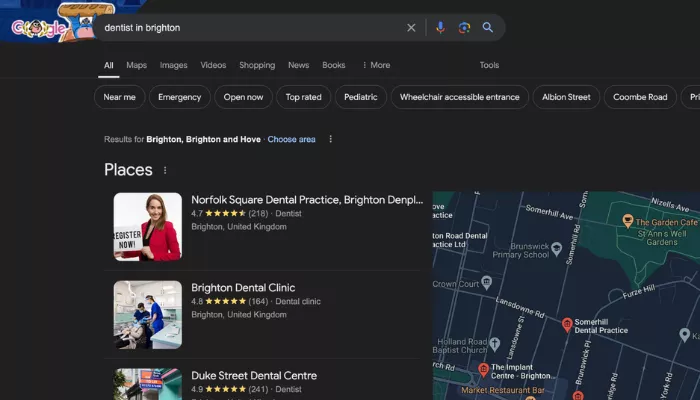
This guide will cover the basics of SEO for dentists and some actionable steps you should consider.
1. Create Direct Landing Pages for Dental Service Keywords
One of the most impactful yet underutilized SEO strategies is creating individual pages for each dental service you offer. Each page should target specific keywords such as “dental fillings” or “laser teeth whitening”.
You can’t expect to rank for these keywords if you don’t create a page for the service and optimize the keyword for it.
Optimizing these pages with local and service-specific keywords helps search engines better understand your offerings and improve the chances of climbing spots in Google’s SERPs.
Arrange the main categories and services underneath them in a precise, logical manner, from main categories such as Orthodontics and General Dentistry to their specific services like Oral Prophylaxis and Porcelain Veneers.
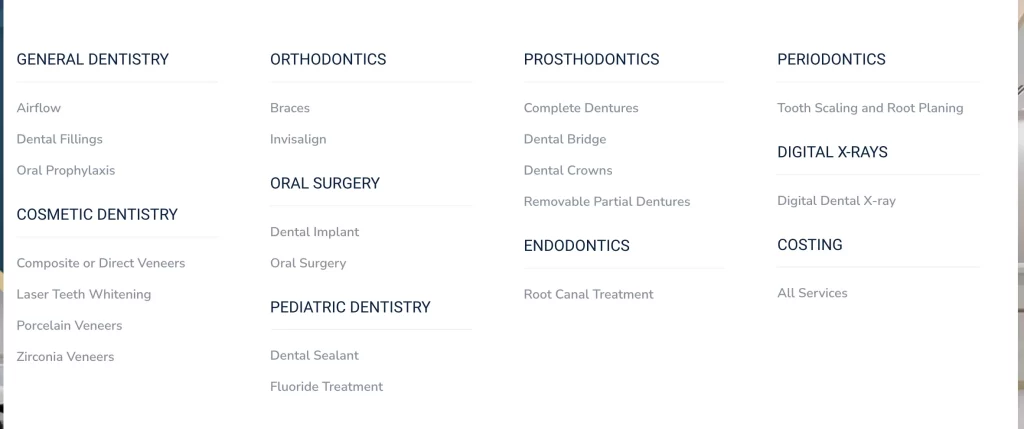
Here’s a quick look at the hierarchy of dental services. You can change it based on your current offerings and local context.
GENERAL DENTISTRY
- Airflow
- Dental Fillings
- Oral Prophylaxis
COSMETIC DENTISTRY
- Composite or Direct Veneers
- Laser Teeth Whitening
- Porcelain Veneers
- Zirconia Veneers
ORTHODONTICS
- Braces
- Invisalign
ORAL SURGERY
- Dental Implant
- Oral Surgery
PEDIATRIC DENTISTRY
- Dental Sealant
- Fluoride Treatment
PROSTHODONTICS
- Complete Dentures
- Dental Bridge
- Dental Crowns
- Removable Partial Dentures
ENDODONTICS
- Root Canal Treatment
PERIODONTICS
- Tooth Scaling and Root Planning
DIGITAL X-RAYS
- Digital Dental X-ray
Publish landing pages with detailed information about the dental service. Include FAQs (Frequently Asked Questions) to address pressing concerns and help potential customers make better decisions about choosing your service (this helps boost the conversion rates for those money pages).
Use internal linking to guide users to related content, assist their navigation experience, and increase their time on your site. Linking related content encourages potential clients to explore your brand further. For instance, if you published the service page on Prosthodontics, link to more specific pages such as Dental Crowns and Dental Bridges.
The better your internal linking strategy, the more page authority it distributes across pages.
2. Apply Author Bio Best Practices
Dentistry falls under the category of "Your Money or Your Life" (YMYL) topics, which refer to subjects that can significantly impact someone’s health, finances, or safety. This means that Google applies stricter guidelines when evaluating content in the field.
Your website must showcase experience, expertise, authoritativeness, and trust (E-E-A-T) to rank well for YMYL topics.
One way to exhibit expertise is to create individual author bios, which can help boost your website's overall brand credibility and SEO performance. Giving users and search engines an idea of the publishers behind every content helps add more positive elements that make your website deserve to rank for its target keywords.
Whether you opt to write blog content as a dentist or hire a medical professional to contribute content for your brand, here are some useful tips to optimize your author bio:
- Include relevant academic degrees, certifications, and professional awards your dentist author has received. Mention the specific institutions and organizations to build more trust with potential patients.
- Use professional headshots similar to those you consistently use across social media platforms, such as the profile photo on LinkedIn. This will create a more recognizable personal brand in the online space.
- Publish a detailed About Us Page. It must include credentials and achievements about your dental practice. Use schema markup to help search engines correctly display your information.
- Link to social media accounts such as Linkedin to help patients verify your qualifications.
3. Optimize Content for Long-Tail Keywords
When starting an SEO campaign, optimizing pages for high-traffic keywords like “dentist near me” is vital as this could bring significant search traffic.
However, if your website is new, it is best to compete for long-tail keywords that are more specific and less competitive. Examples are “Teeth whitening treatment cost in London” or “How often should I get a dental cleaning?”
This enables your newly optimized website to acquire initial traffic by ranking in less time for long-tail keywords.
It is best to incorporate these long-tail keywords naturally throughout your helpful content.
Here are some examples of dental-related long-tail keywords:
- Best family dentist near [city]
- Affordable cosmetic dentistry in [city]
- Emergency dental care for a broken tooth near me
- How to find a good pediatric dentist in [city]
- Teeth whitening treatment cost in [city]
- Dental implants specialist in [city]
- Pain-free root canal treatment near [city]
- Invisalign vs braces cost in [city]
- How often should I get a dental cleaning
- Gum disease treatment options for seniors
- What to do for a knocked-out tooth emergency
- Sedation dentistry for dental anxiety in [city]
- Best dentist for veneers in [city]
- What to expect during a dental implant consultation
- Holistic dental care for sensitive teeth
4. Encourage Patients to Leave Reviews
Patient reviews are critical in building trust with potential patients. As Google considers the quality of reviews a significant local ranking factor for local businesses, having quality reviews can help your site dominate the top ranking spots.
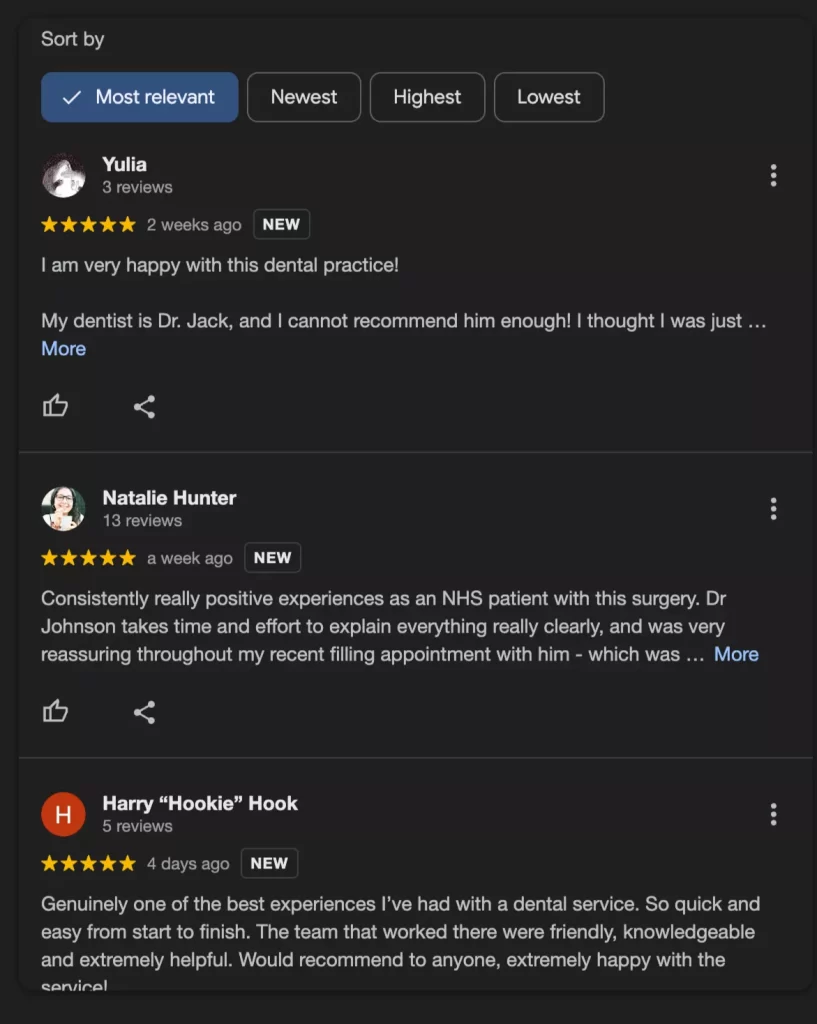
You can display printables in your office with a QR code to encourage patient feedback. Others fashionably use physical marketing materials to help patients share their experiences online.
5. Optimize Google Business Profile
Google Business Profile creation is one of the most fundamental initiatives to help your dental website rank for Google Map Packs.
Fill out all the essential details in the profile to maximize its full potential. A properly optimized profile must include:
- Name, phone number, and address also being placed on your dental site (make sure you consistently place just one NAP - Name, Phone Number, and Address).
- Accurate business hours, contact information, and appointment links
- High-quality images of your clinic, staff, and services
Regularly update your GBP with new promotions, events, and services. All these updates help engage your audience and give Google more content to crawl, which can positively impact your local rankings.
6. Be Visible in Comparative Pages
Getting coverage on publications that rank well in Google’s SERPs for comparative inquiries, like “best orthodontists in London”, could help position your brand strongly online.
We’ve had several names for this type of strategy, as some SEOs have coined it Barnacle SEO, Second-Hand Search Traffic, or Parasite SEO. The goal in any of these is to dominate the top page of SERPs by ranking for comparative pages where you can be appropriately included as a service provider.
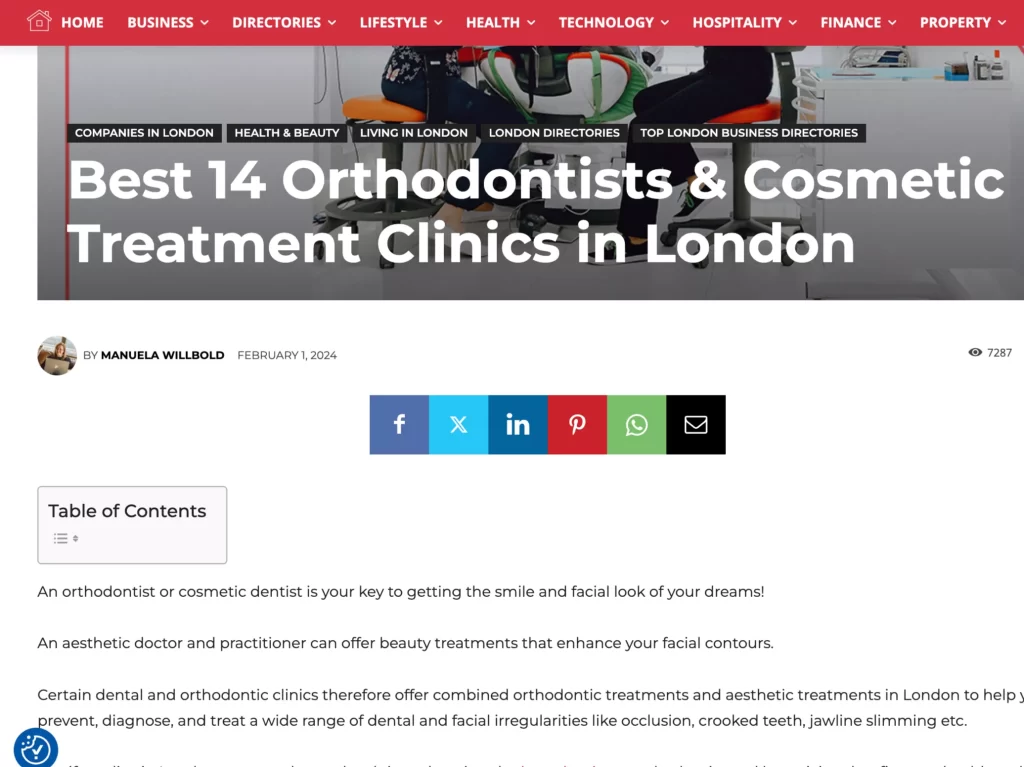
Being visible on these ranking comparative pages can help increase brand share and recall for searchers looking for the best dental clinic in town.
7. Be Included in Local and Healthcare Directories
While getting links from local and niche directories is often misunderstood as merely a link building technique, their value in driving exposure for a dental brand is crucial.
Most users today consider directories a source of options when finding a particular service. They seek niche directories to increase their options, compare service providers, and find the one that will serve their needs.
Start creating and optimizing profiles for healthcare directories like ZocDoc and HealthGrades, as these sites often rank highly on Google’s SERPs.
Drive More Patients to Your Dental Practice
SEO for dentists requires a holistic approach that goes beyond just setting up a Google Business Profile.
By applying the strategies that strongly demonstrate EEAT to help your site foster trust and credibility for search engines and users, you can build a sustainable flow of new patients who trust your practice.
SEO for Family Law: Proven Strategies to Attract More Clients
In the competitive law firm SEO, particularly in family law, getting online visibility is everything. With potential clients turning to Google to find legal services to serve their needs, having a lawyer website that dominates Google’s search engine results pages (SERPs) ensures you’re adding a mix to your marketing strategy.
Working with law firms, I’ve noticed that, more often than not, a typical legal website is just a repository of landing pages that aren’t fully optimized for search, leaving clients with few opportunities to find their legal services.
In this quick guide, we’ll look at the fundamentals of SEO for family law to attract more clients.
1. Structure Menu Items Based on Hierarchy
One way to improve user experience and your site's ability to rank for search is to structure your menu items in a clear, hierarchical manner. This involves arranging the main categories and subcategories in a precise, logical sequence.
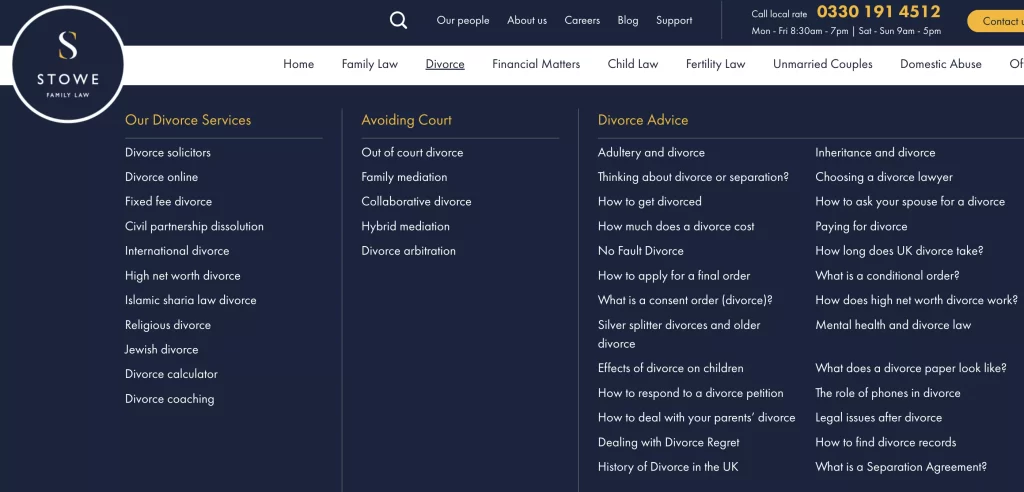
A well-structured menu helps users navigate the website more intuitively and ensures important pages are discovered and indexed correctly. This can improve overall site coverage and rankings for your key pages.
For instance, a parent category labeled “Services” might have categories like “Divorce and Separation”, “Child Custody and Support”, and “Mediation Services”, with more specific landing pages.
Here’s how it looks like in order, for example:
Services
- Divorce and Separation
- Child Custody and Support
- Property Division
- Spousal Support
- Child Custody and Support
- Custody Agreements
- Visitation Rights
- Child Support Modifications
- Mediation Services
- Divorce Mediation
- Family Dispute Mediation
- Child Custody Mediation
- Prenuptial and Postnuptial Agreements
- Adoption Services
- Domestic Violence
- Restraining Orders
- Emergency Protective Orders
2. Rank For Local Organic Listings and Google Map Packs
Local SEO is a critical component for family law firms, as a typical scenario for most clients seeking lawyers near their homes.
Having your legal website at the top of local organic listings and Google Maps packs helps drive new inquiries for your law firm.
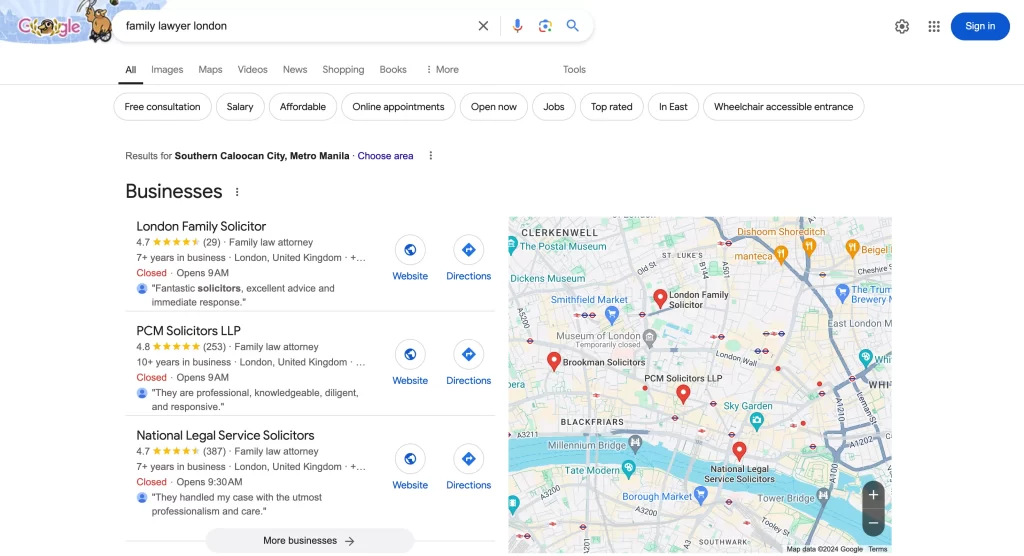
Here are a few action items to optimize your family law site for local search:
- Claim and optimize your Google My Business (GMB) profile.
- Ensure that the firm’s name, address, and phone number (known as NAP in local SEO) are accurate and consistent on your site and other off-page sites, such as citations and local directories.
- Incorporate location-specific keywords in your site’s content, such as “family lawyer in London” or divorce attorney in Brighton”.
- Produce helpful content that resonates well with the local community. Topics may include local laws affecting family matters and comprehensive guides on navigating divorce in your city or region.
- Be listed in citations and legal directories. Your firm should be listed in reputable legal platforms like The Law Society's Solicitor Directory and The Legal 500.
- Ask for reviews from clients. Reviews can help improve your GMB’s rankings for Google Map Packs.
3. Distribute External Content Assets
Contributing content assets to other relevant publications and blogs (guest posts) can help improve your site’s EEAT (Experience, Expertise, Authoritativeness, and Trustworthiness), as these qualities are showcased in the content's caliber.
Through expertly crafted content pieces, you can demonstrate expertise and experience signals that won’t just attract referral traffic and direct visits but potentially assist conversions on backlinks from publications you’re contributing to.
One good example is this law firm in London that distributes content across relevant verticals, i.e., parenting, mommy, and family blogs. All of these have audiences where they can acquire potential clients.
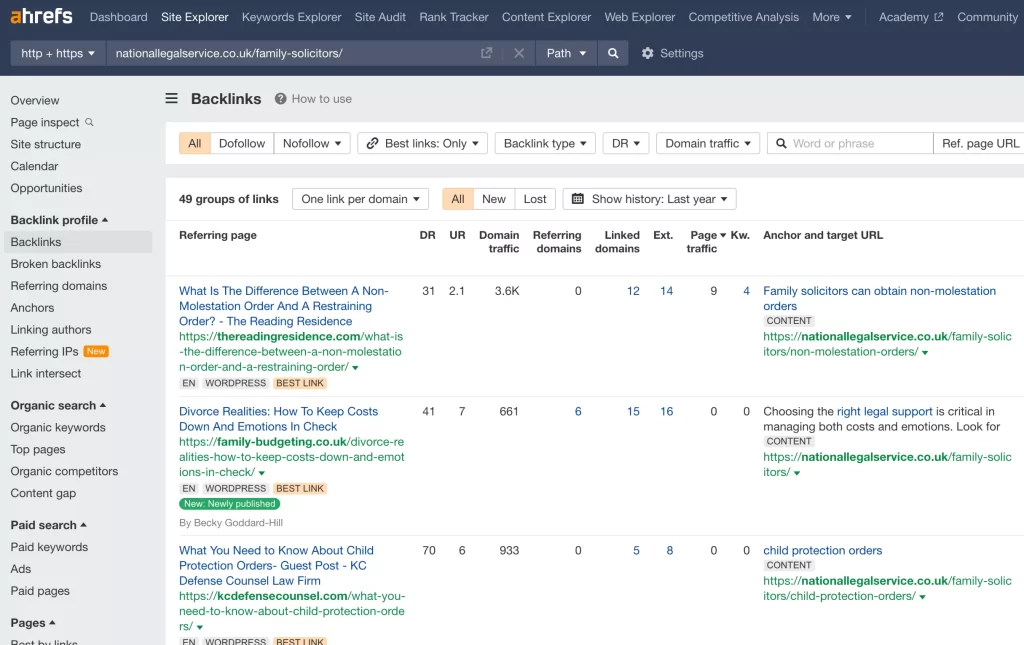
Here’s my list of recommended topics where you can generate even more specific guest blogging ideas:
- Co-Parenting Strategies - Tips and advice on effective co-parenting after divorce, including communication strategies and conflict resolution. (parenting)
- Child Custody and Visitation Rights - legal aspects of child custody, visitation rights, and how to navigate the court system. (parenting)
- Divorce and Family Dynamics - the impact of divorce on family dynamics and how to maintain a healthy environment for children. (parenting and family)
- Financial Planning for Divorced Parents - how to manage finances post-divorce, including child support, alimony, and budgeting tips. (finance and family)
- Legal Rights of Parents: Information on the legal rights of parents in various situations, such as custody disputes, relocation, and schooling decisions. (parenting)
- Domestic Violence Awareness and Resources: Articles focused on recognizing, addressing, and escaping domestic violence, along with legal resources available for victims. (family)
- Prenuptial and Postnuptial Agreements: Educating readers on the importance of these agreements and how they can protect both parties in a marriage. (wedding, family)
- Adoption Process and Legal Considerations - legal process of adoption, including the rights of biological and adoptive parents. (family)
- Mediation vs. Litigation in Family Disputes: The benefits of mediation over litigation in resolving family disputes, including cost, time, and emotional impact. (family)
- Supporting Children Through Divorce: Psychological and legal support for helping children cope with the changes that come with divorce. (family)
- Estate Planning for Families: How to protect your family's future through proper estate planning, including wills, trusts, and guardianship considerations. (real estate, family)
- Parental Rights in Same-Sex Marriages: Legal considerations and challenges. Unique to same-sex couples in matters of adoption, custody, and parental rights. (family, parenting, wedding)
The key to producing any of the mentioned topics is to align it with your contributor’s expertise and experience, as both these attributes will directly impact the quality of the content.
4. Ask For Links From Clients or Networks’ Sites
The legal industry heavily relies on networks to acquire clients. While this could directly affect how the law firm grows as a business, this network, in the form of clients and friends, is also a good source for link building.
You can ask for links from clients or people you’ve known who have their own websites. It may not be as relevant as it is. Still, from the local level, if the website happens to be hosted within a geographic area, it will have a solid value to your law firm, as local backlinks tend to bring more link equity as opposed to getting national links as its counterpart.
